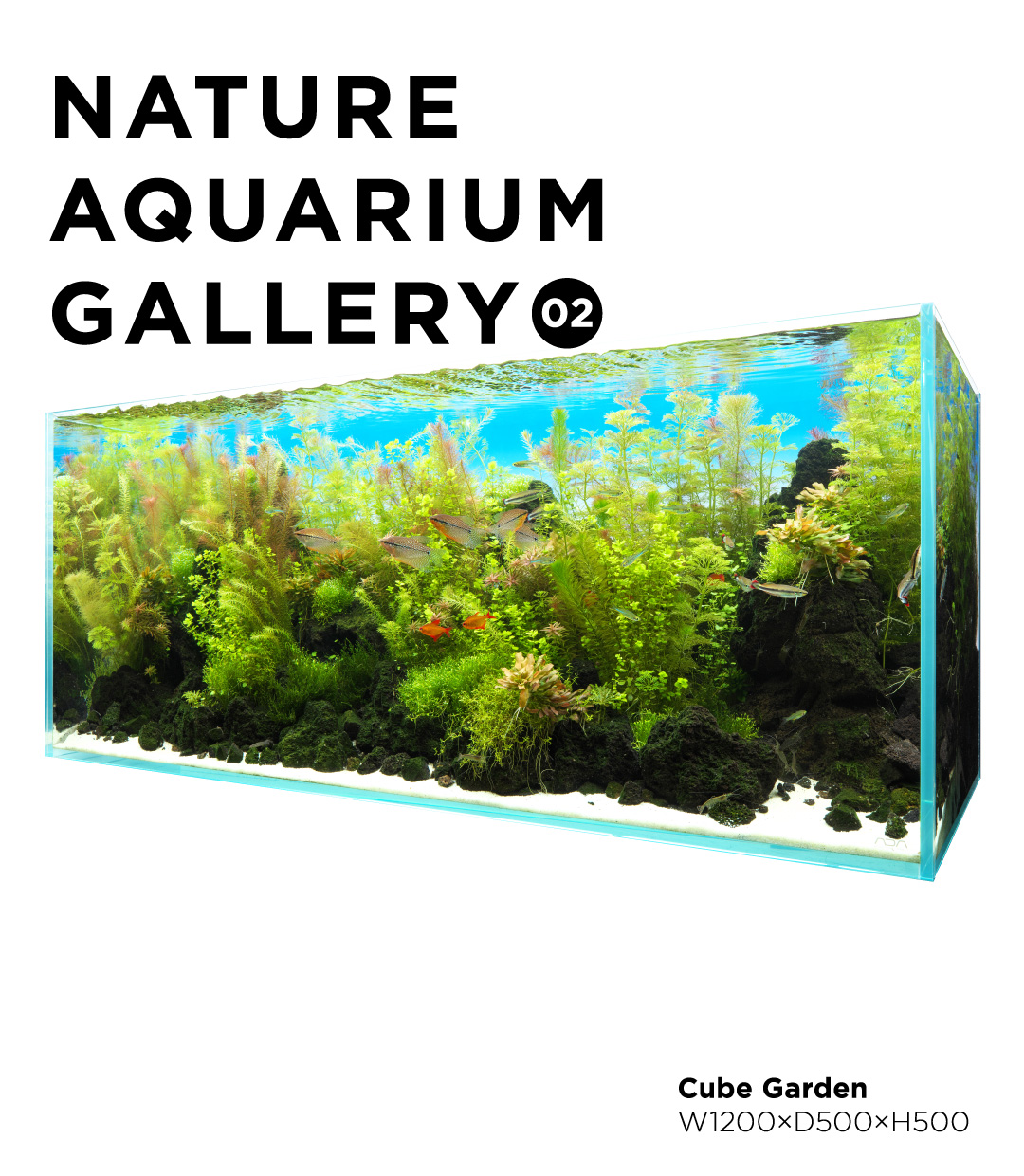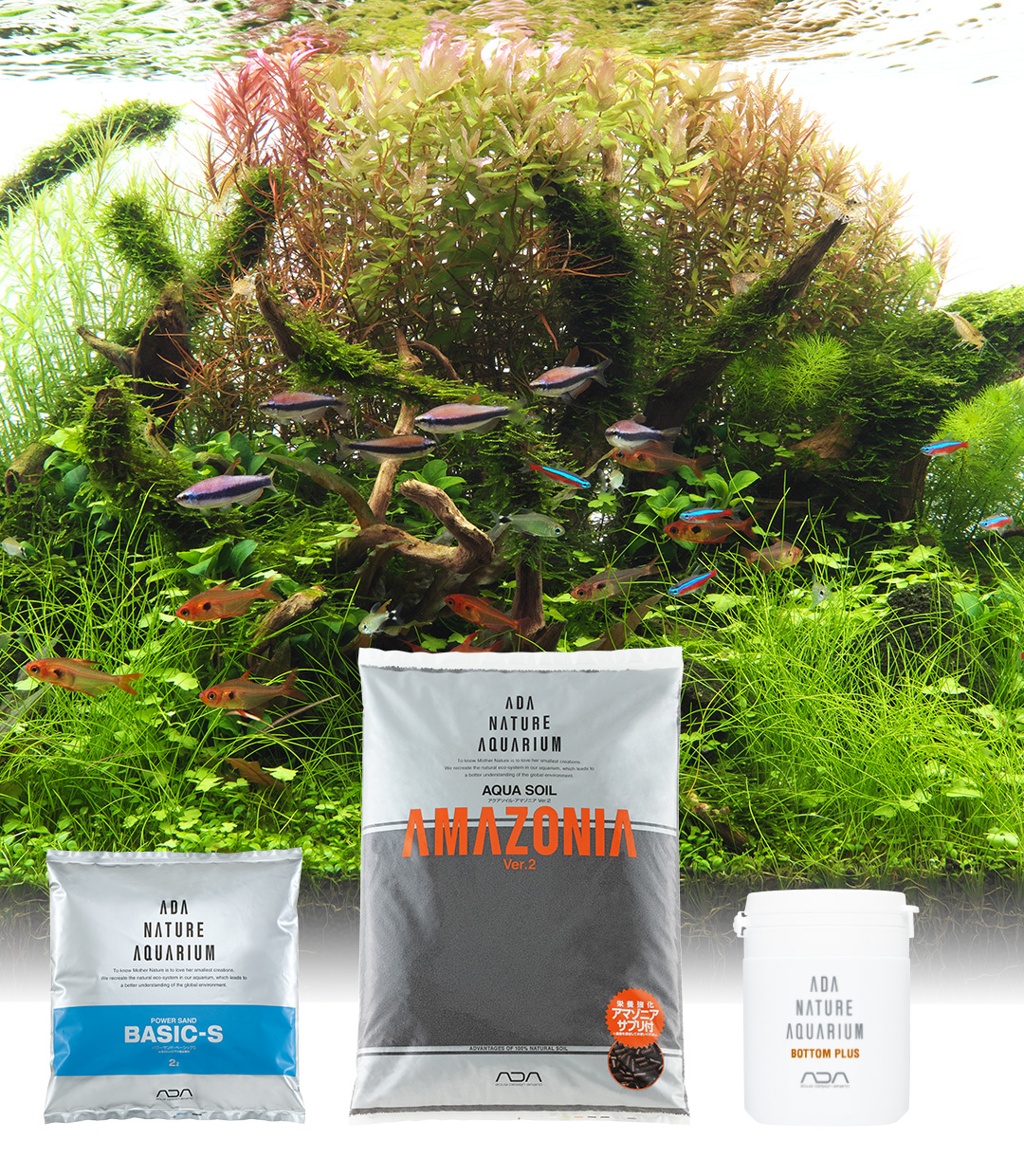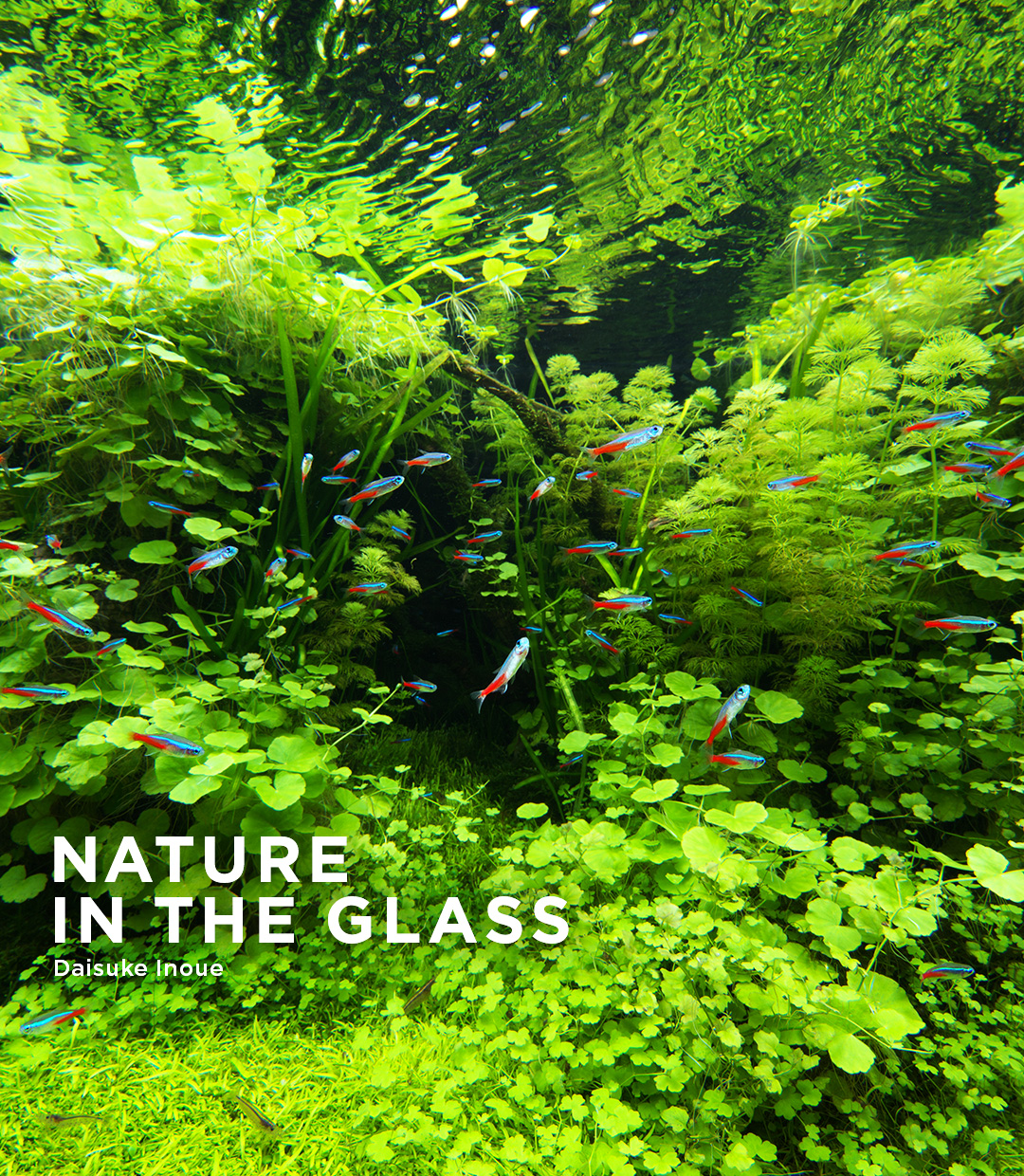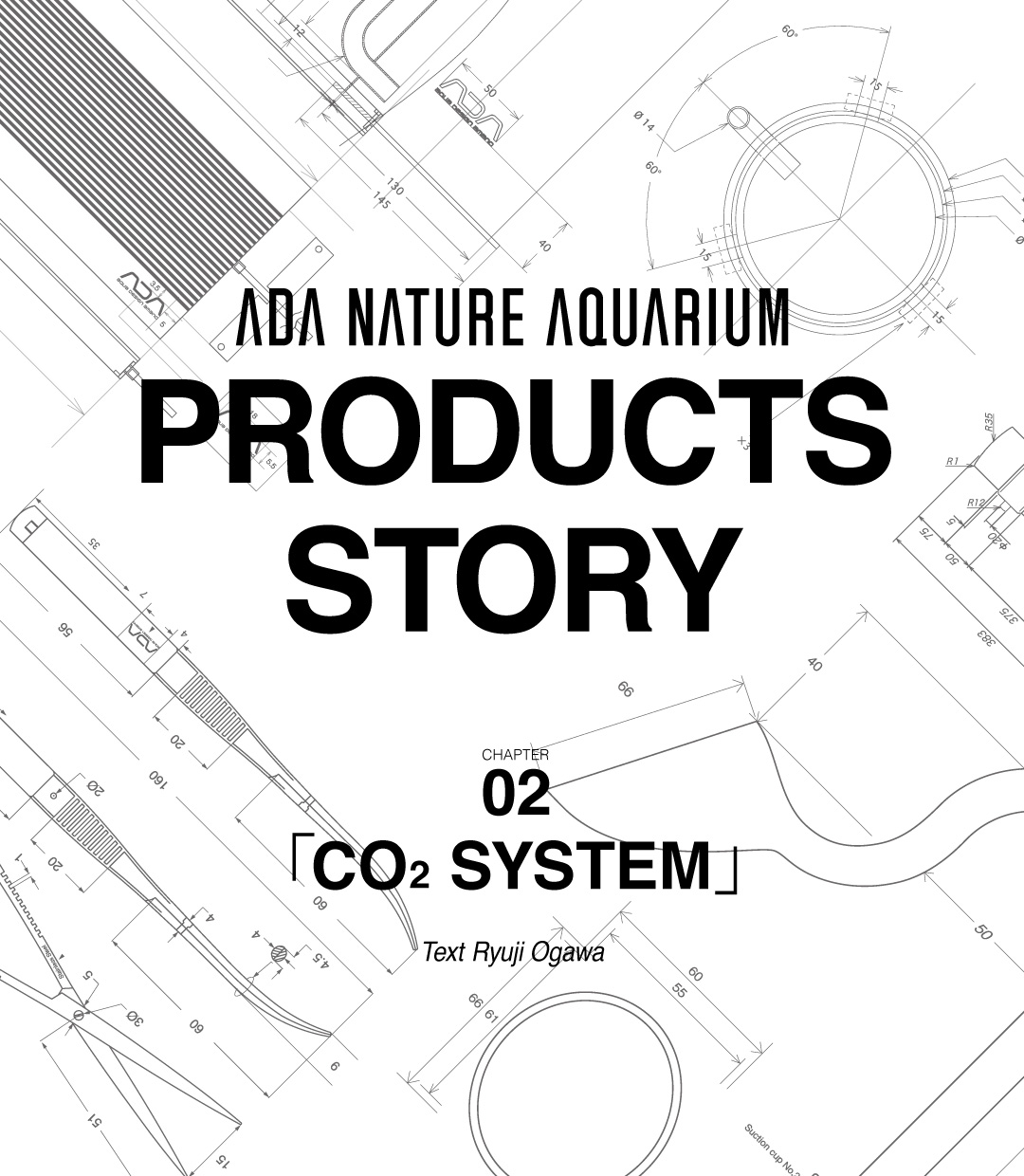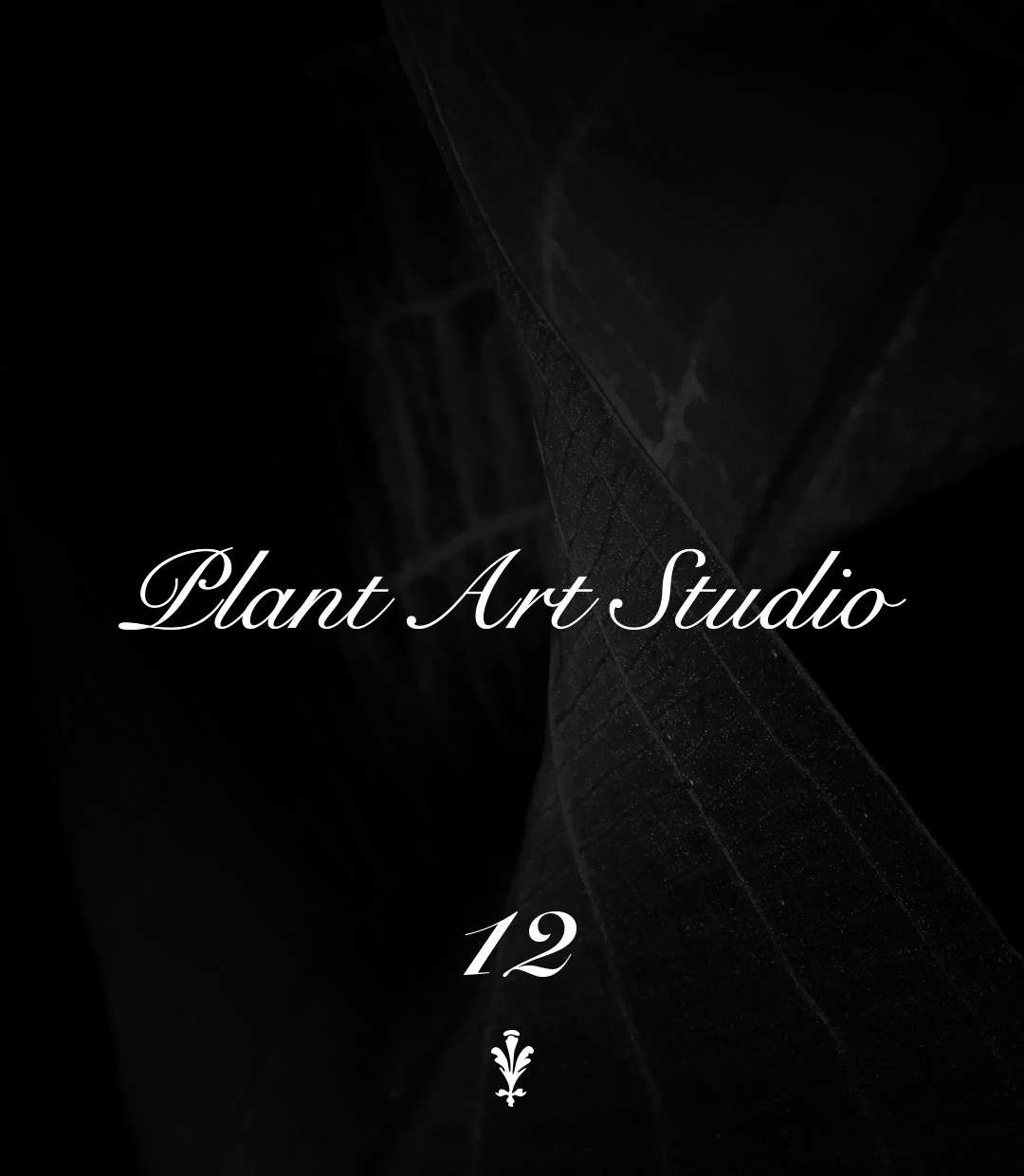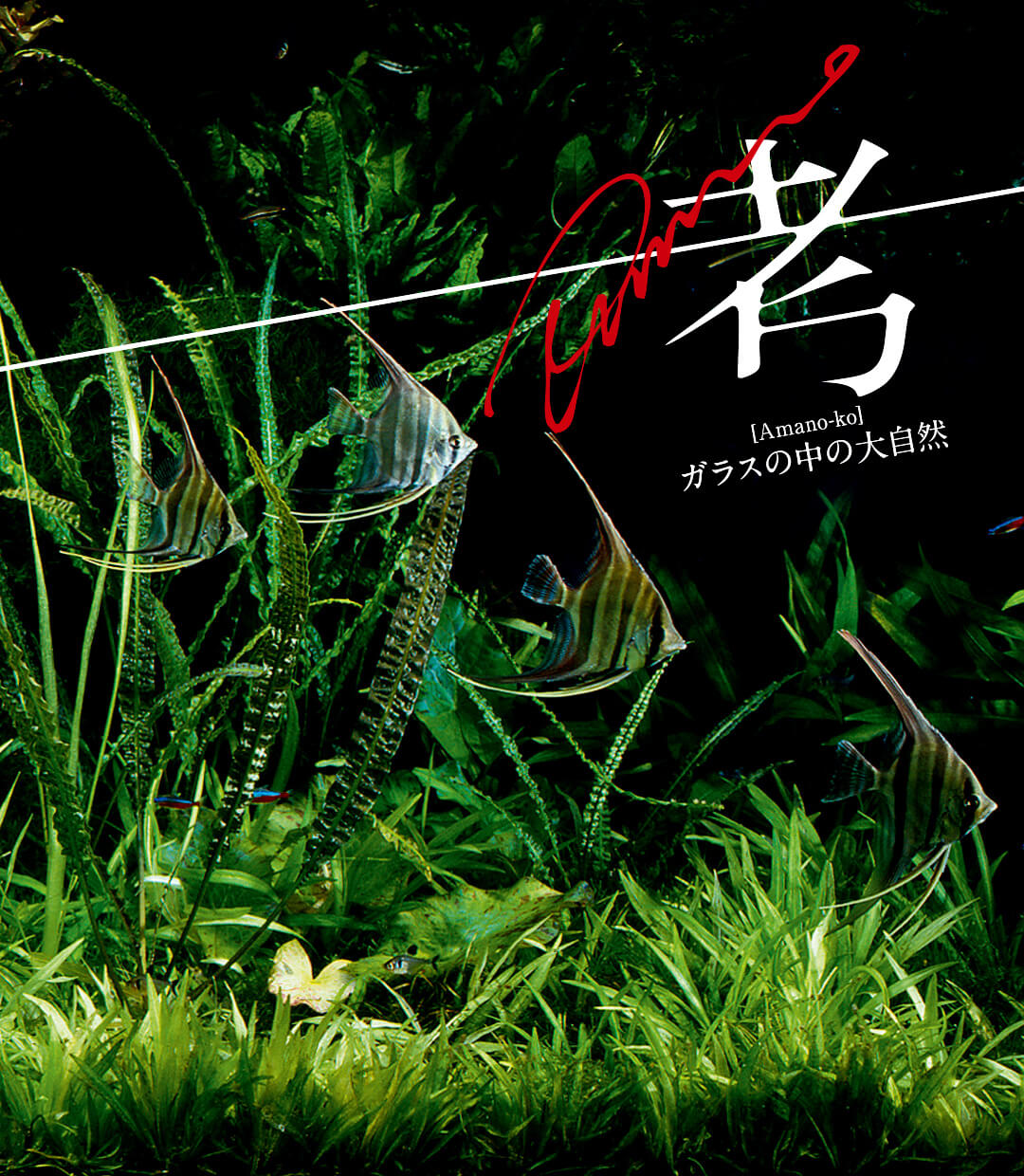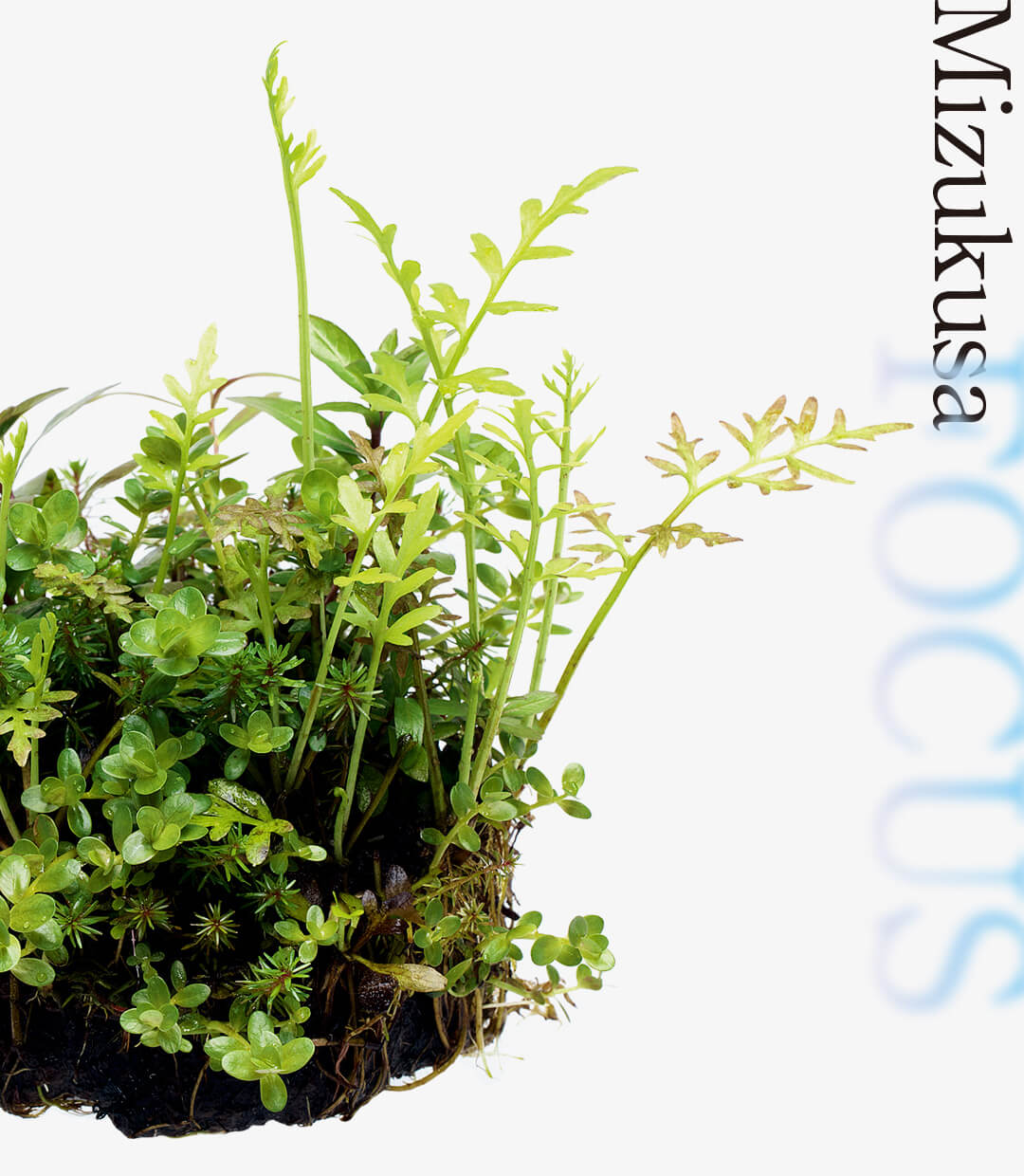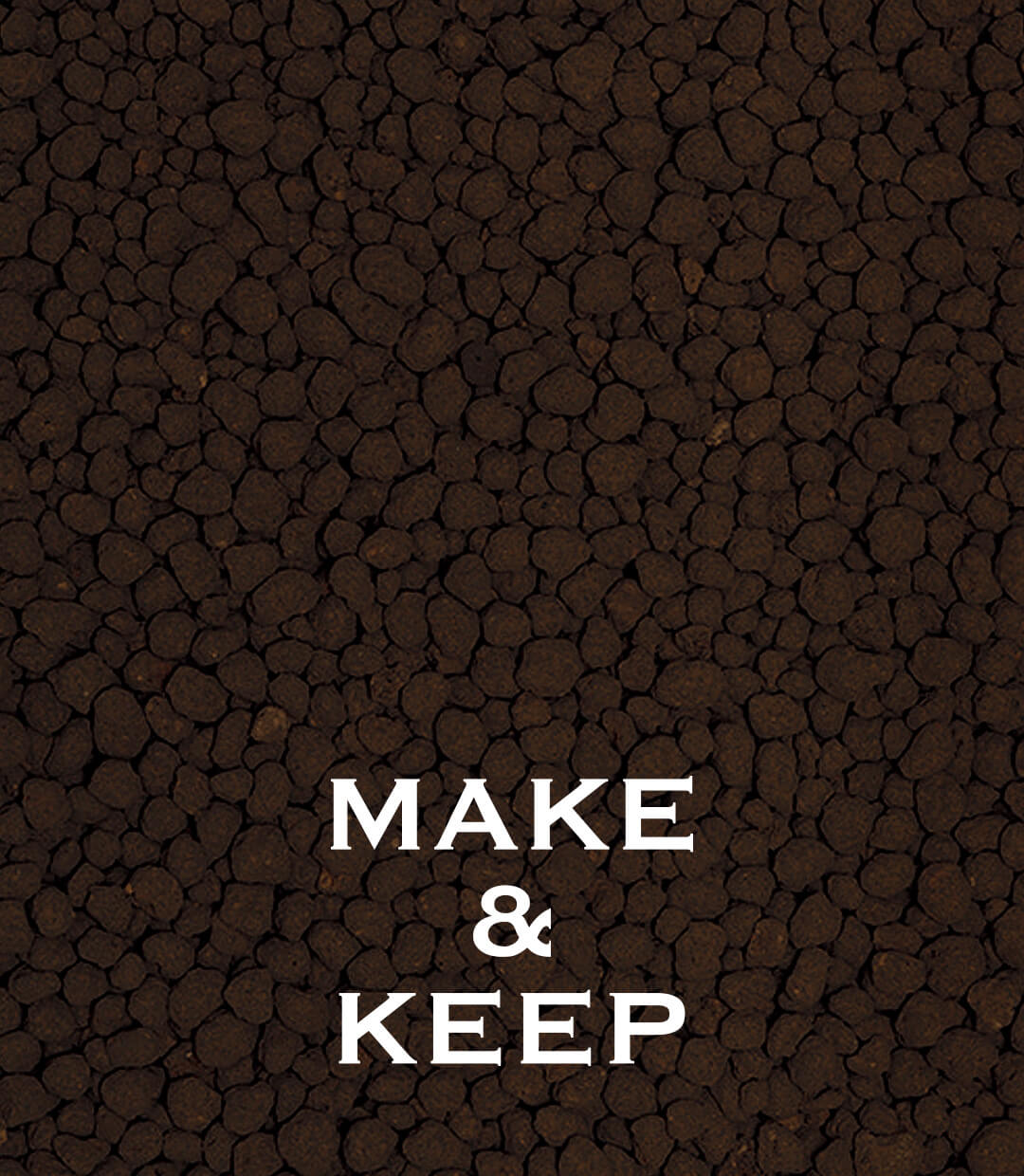NATURE IN THE GLASS ‘Green Heaven’
Creating a mystical aquascape with light-green foliage glowing in the dark
In the dark, when chasing countless glowing lights, there is a mystical forest with a floaty feeling underwater. This aquascape was created while envisioning such a story. At a glance, this aquascape gives a strong impression of Hydrocotyle types, but it is purposely created in a way that you cannot remember how the layout looks even if you try to remember it because of its vague impression. And every time small Paracheirodon innesi swim around, they radiantly sparkle and add a beautiful touch to the mystical world.
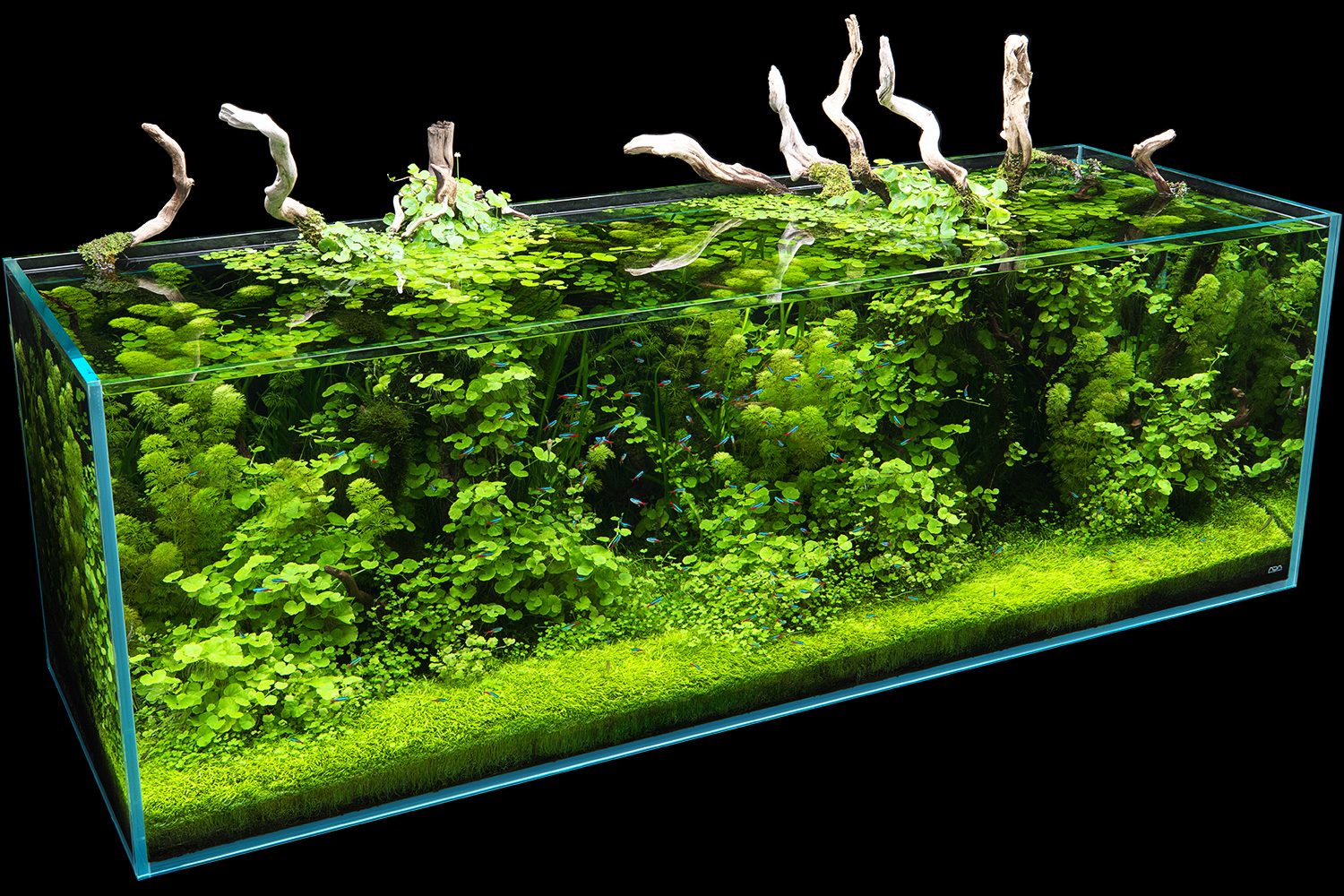
DATA
Photo: November 26th, 2020(ADA)
Creator: Daisuke Inoue
Aquarium: Cube Garden W180×D60×H60(cm)
Lighting: Solar RGB x 3, turned on for 8.5 hours per day
Filter: Super Jet Filter ES-2400(Bio Rio L)
Material: Branch Wood, Sansui Stone
Substrate: Aqua Soil – Amazonia Ver.2, Power Sand Advance L, Bacter100, Clear Super, Tourmaline BC
CO2: Pollen Glass Beetle 50Ø, 10 bubbles per second via CO2 Beetle Counter (using Tower)
Aeration: 15.5 hours after the light is turned off using Lily Pipe P-6
Additives: Brighty K, Green Brighty Mineral, Green Brighty Nitrogen, ECA Plus
Water change: 1/2 once a week
Water quality: Temperature: 24ºC; pH: 5.8; TH: 20 mg/l
Plant
BIO Mizukusa no Mori Utricularia graminifolia
BIO Mizukusa no Mori Hydrocotyle tripartita
BIO Mizukusa no Mori Taxiphyllum barbieri
Hydrocotyle leucocephala
Cardamine lyrata
Limnophila sessiliflora
Vallisneria neotropicalis
Limnobium sp.
Fish
Paracheirodon innesi
Crossocheilus oblongus
Otocinclus sp.
Caridina multidentata
Photo: November 26th, 2020(ADA)
Creator: Daisuke Inoue
Aquarium: Cube Garden W180×D60×H60(cm)
Lighting: Solar RGB x 3, turned on for 8.5 hours per day
Filter: Super Jet Filter ES-2400(Bio Rio L)
Material: Branch Wood, Sansui Stone
Substrate: Aqua Soil – Amazonia Ver.2, Power Sand Advance L, Bacter100, Clear Super, Tourmaline BC
CO2: Pollen Glass Beetle 50Ø, 10 bubbles per second via CO2 Beetle Counter (using Tower)
Aeration: 15.5 hours after the light is turned off using Lily Pipe P-6
Additives: Brighty K, Green Brighty Mineral, Green Brighty Nitrogen, ECA Plus
Water change: 1/2 once a week
Water quality: Temperature: 24ºC; pH: 5.8; TH: 20 mg/l
Plant
BIO Mizukusa no Mori Utricularia graminifolia
BIO Mizukusa no Mori Hydrocotyle tripartita
BIO Mizukusa no Mori Taxiphyllum barbieri
Hydrocotyle leucocephala
Cardamine lyrata
Limnophila sessiliflora
Vallisneria neotropicalis
Limnobium sp.
Fish
Paracheirodon innesi
Crossocheilus oblongus
Otocinclus sp.
Caridina multidentata
3 points for expressing a mystical aquascape in a layout
The concept for this layout is to express a mystical world that I envision in my mind in an aquarium tank, instead of getting inspirations from natural scenery. So, I created the hardscape, planted and chose fish in a resourceful manner to make the impression of the aquascape mystical. The purpose is to make the aquascape unforgettable after seeing it once, but to make it look abstract.
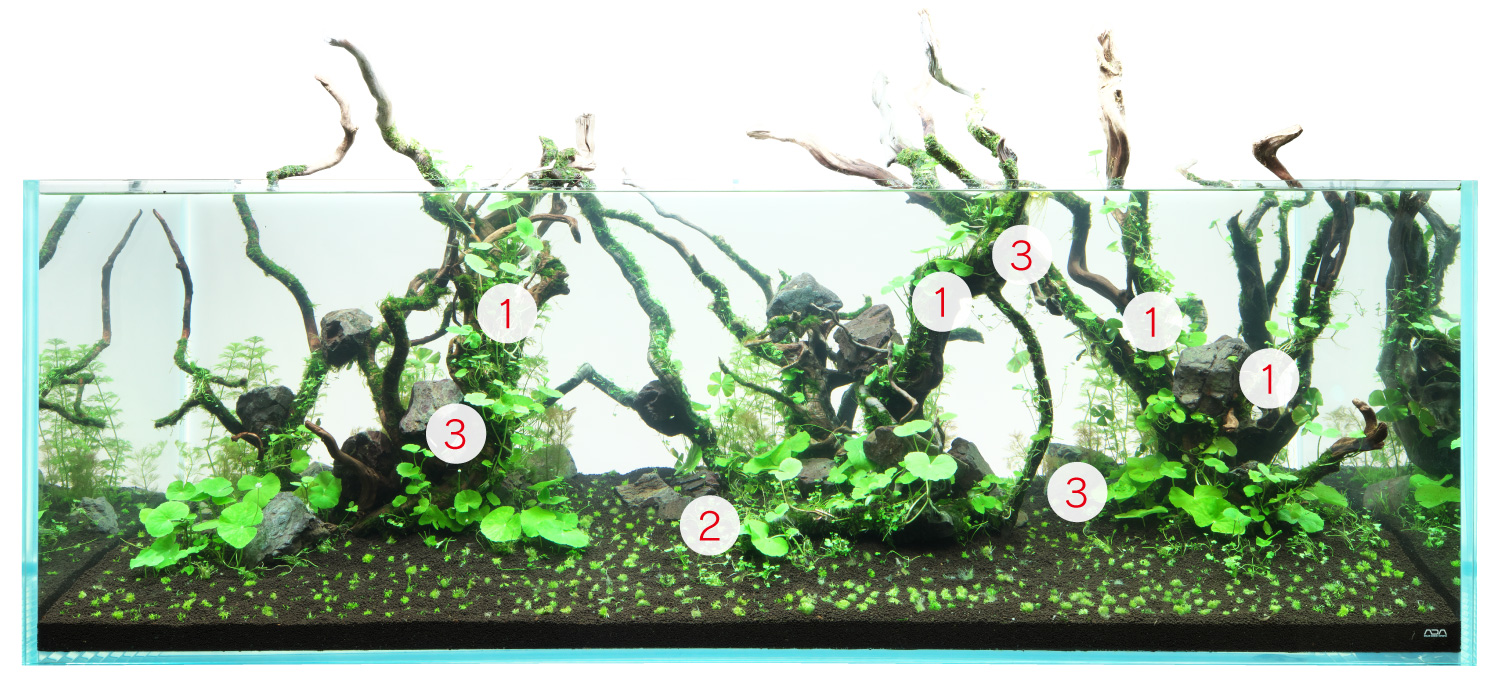
①Create a floaty feeling of aquatic plants
To create a floaty feeling underwater, a type of Hydrocotyle was widely used as a main aquatic plant. Its roundish leaves with long internodes create a floaty feeling in the water.
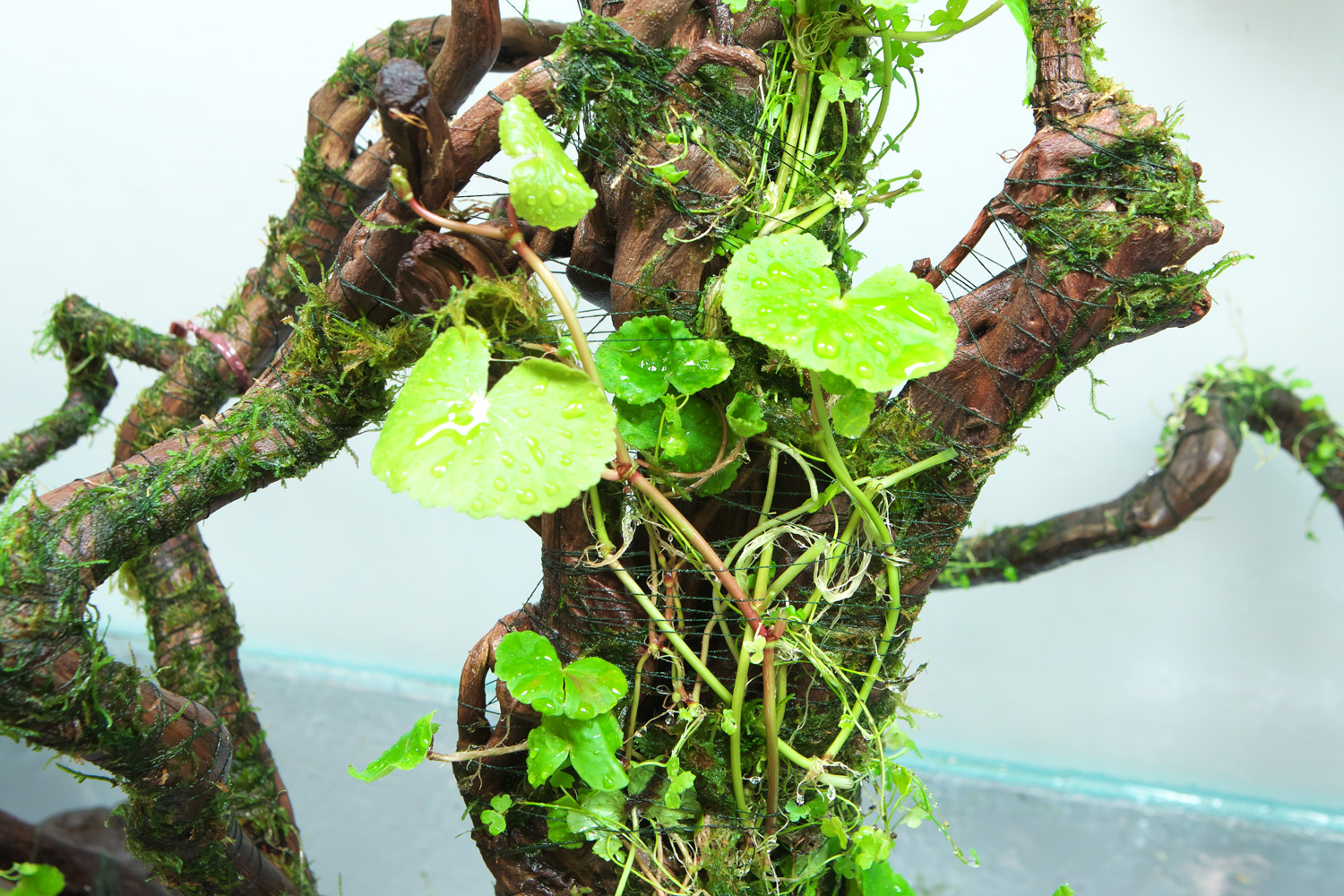
To show how Hydrocotyle leucocephala spreads out from the bottom of the water toward the water surface while growing, Hydrocotyle leucocephala was wound around the upper part of the driftwood too.
②Make the boundaries of aquatic plants blurry
By having similar aquatic plants in colors and shapes, the boundaries of aquatic plants become unclear, and the overall impression of the aquascape appears blurry.
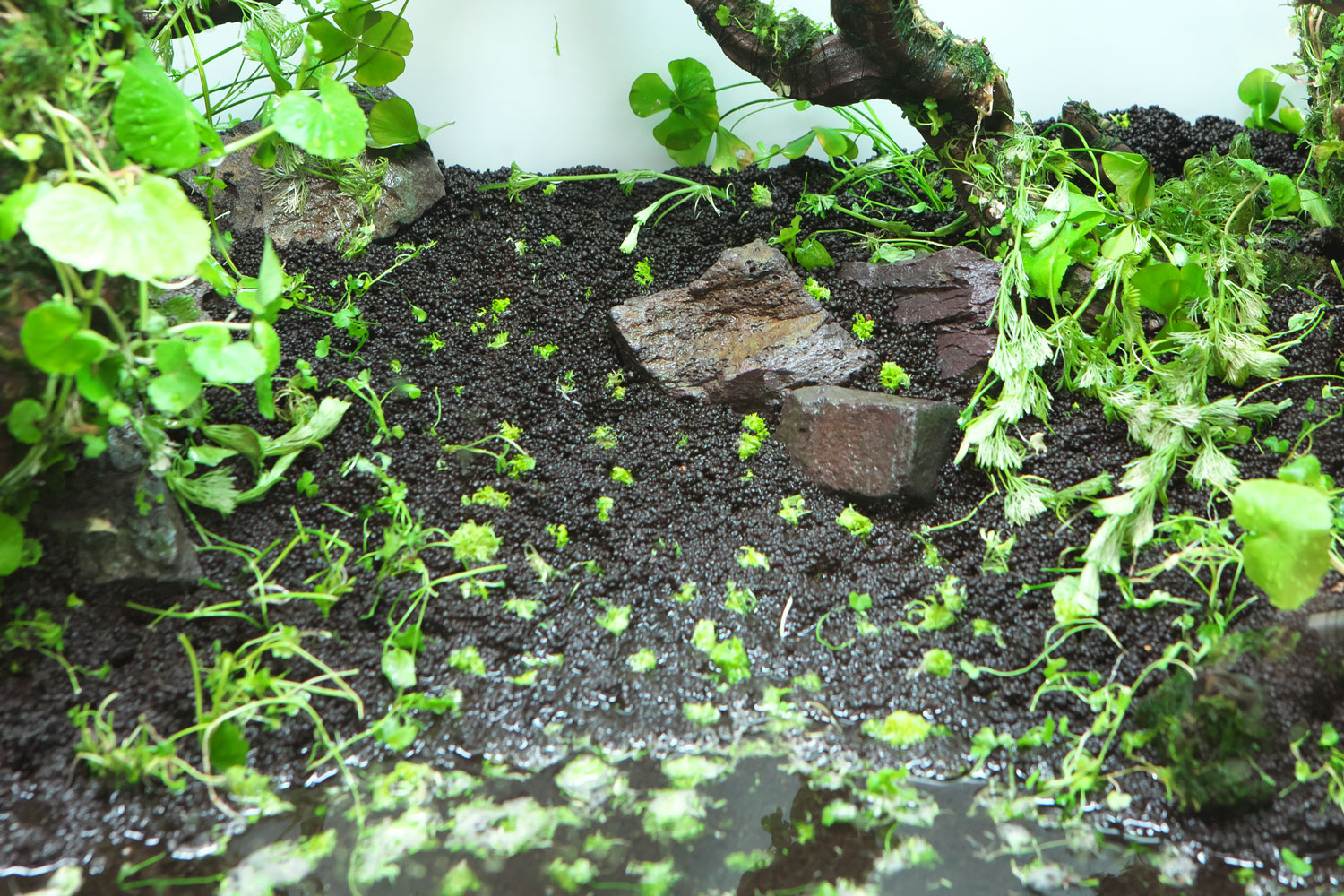
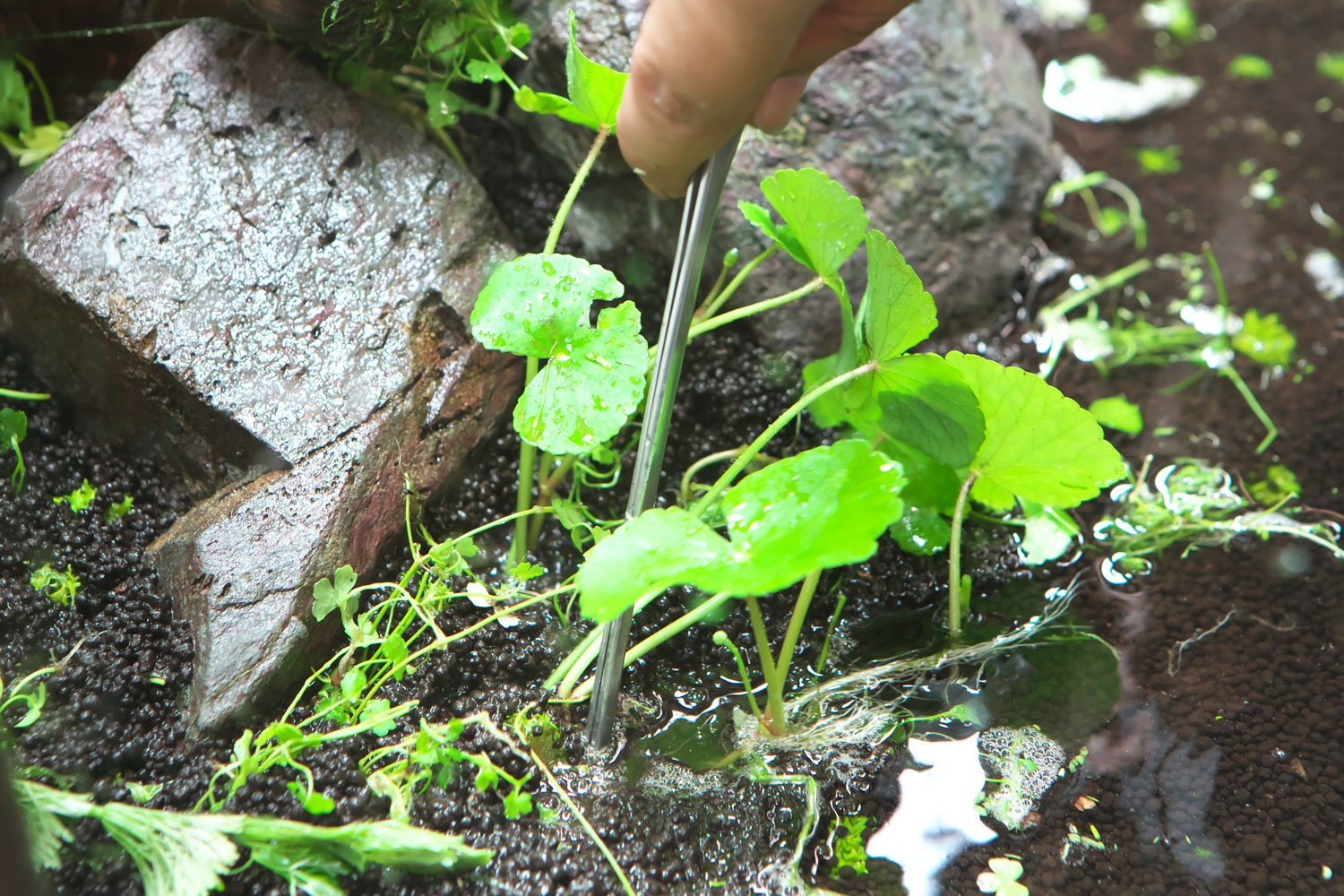
③Make the aquascape look even more mystical by emphasizing the light and shadow
In contrast to the bright light-green colored aquatic plants, by creating dark parts, I aimed for an effect that the aquatic plant leaves appear in a way that they are emerging underwater.
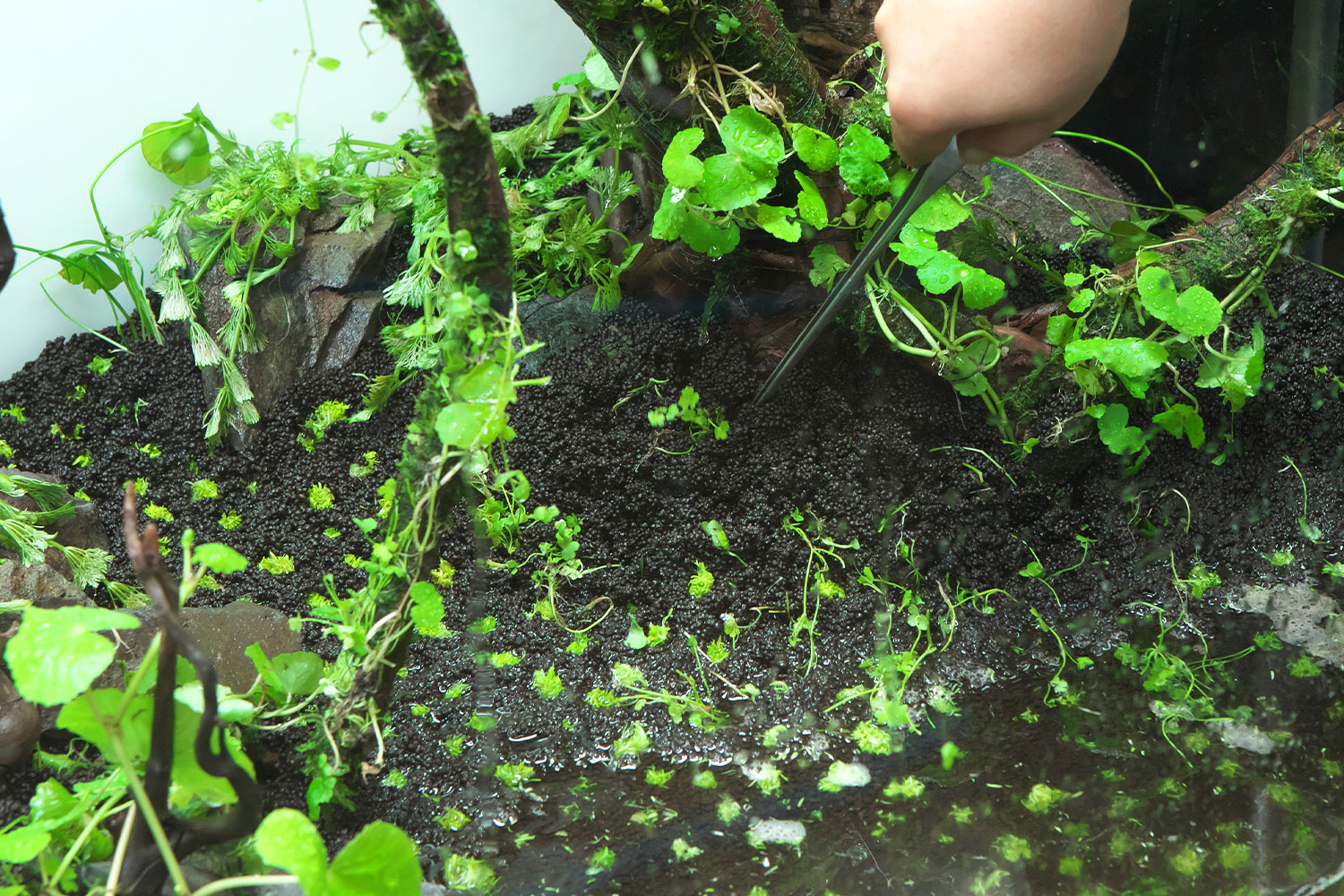
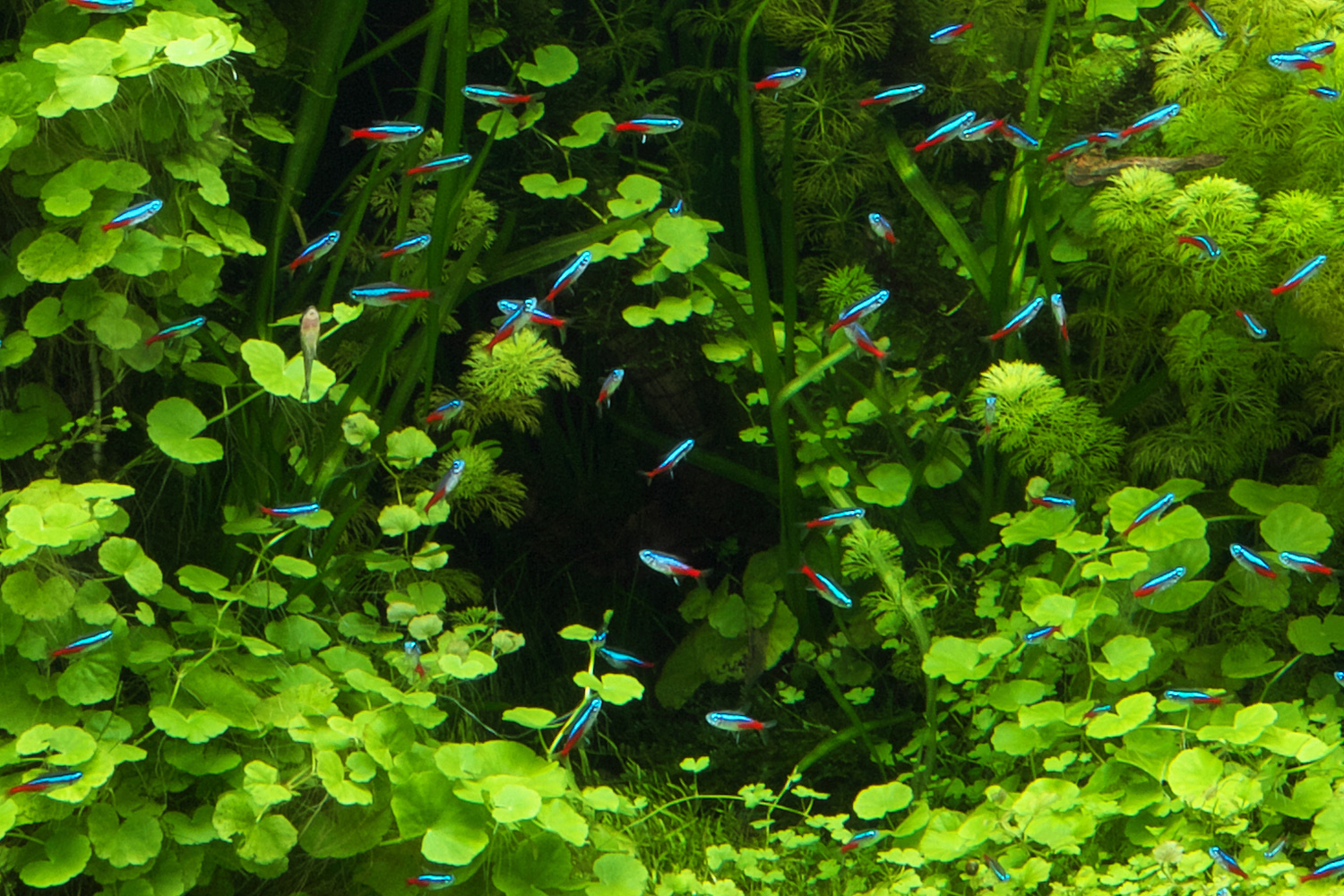
I purposely had small Paracheirodon innesi swim around instead of having eye-catching fish. Although it is hard to see them at a distance, the way they sparkle in blue and red adds a mystical touch to the entire aquascape. And its popular look worked well in this aquascape too.
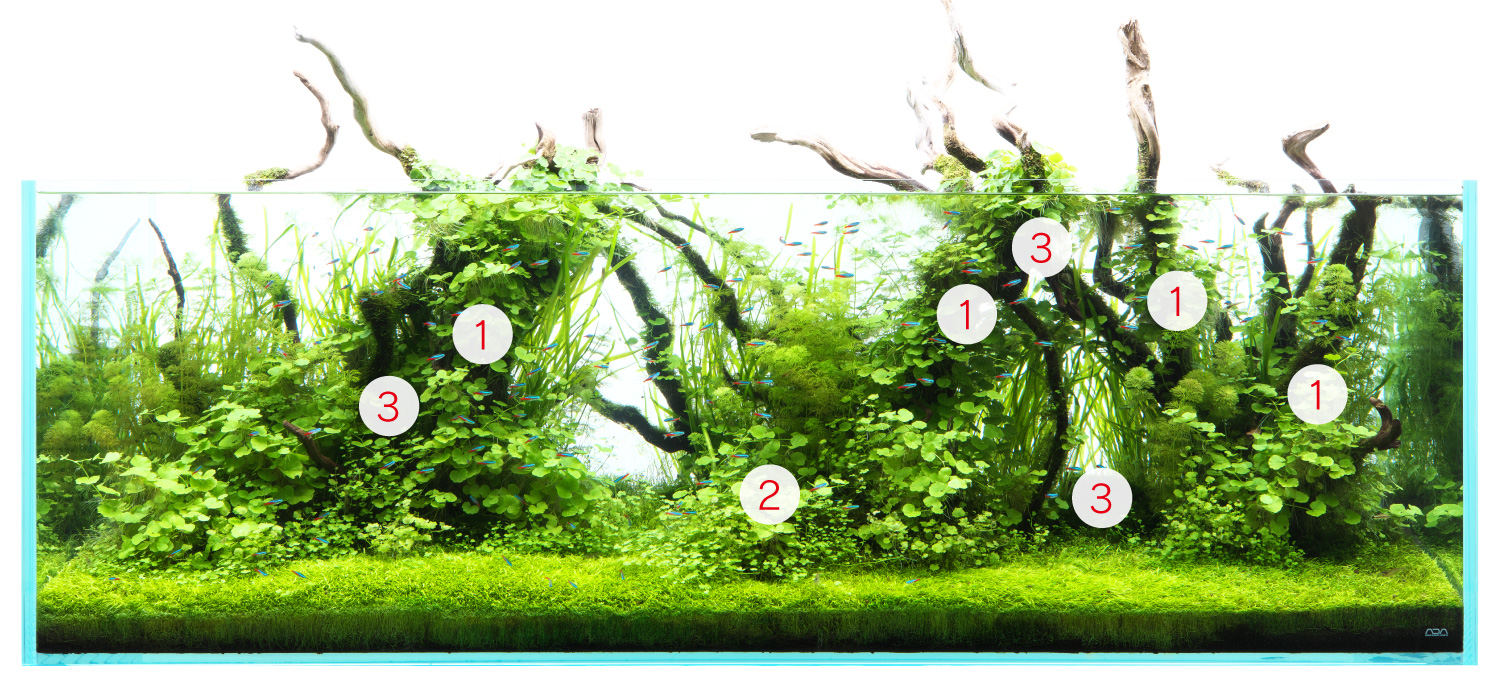
The other side of flexible maintenance that reflects the creator’s intention
Planting that takes advantage of a mystical expression is the theme for this aquascape. Because aquatic plants I used a lot for this aquascape are types of Hydrocotyle, most of them are heliophytes which prefer light. In order to promote the coexistence of the aquatic plants, I tried to do the maintenance work, so that light reaches all the plants.
Picking moderately【 Hydrocotyle leucocephala 】
In this aquascape which was created based on the mystical view of the world as the creative theme, in order to create a floaty feeling, I wound Hydrocotyle leucocephala that is not an epiphytic aquatic plant around the driftwood, and had it grow along the driftwood like ivy. Because it was necessary to make it always grow along the driftwood, I used Terra Line that doesn’t melt over a long period of time without winding too many times, and paid attention not to crush the leaves.
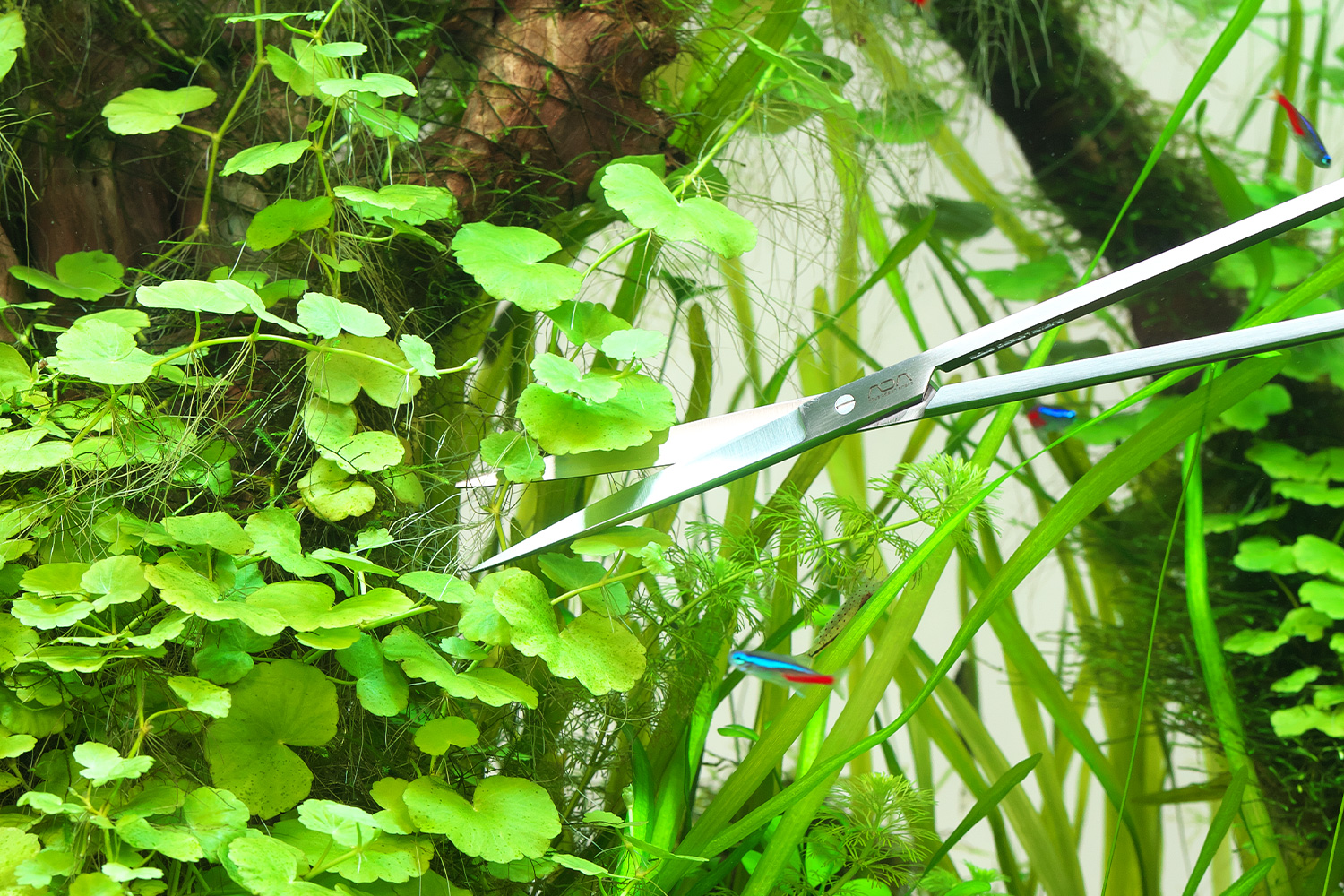
Because leaves that popped out to the side instead of growing along the driftwood, would block off the light, I moderately picked some of them. When stems of Hydrocotyle leucocephala developed without following the driftwood as they grew, I tried to maintain the scenery for a long time by re-winding Hydrocotyle leucocephala.
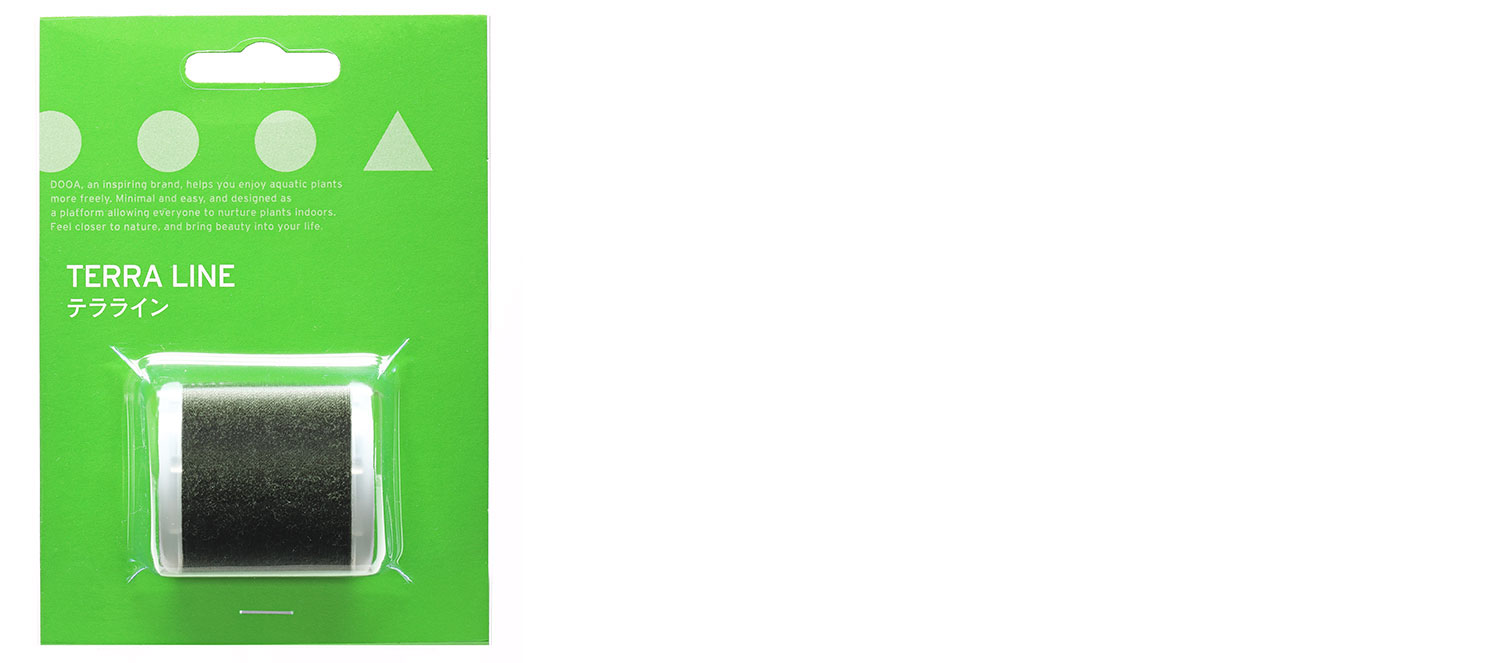
Terra Line
When you want to make aquatic plants without a rooting ability grow along composition materials, Terra Line is more suitable than Moss Cotton because it doesn’t melt in the water.
When you want to make aquatic plants without a rooting ability grow along composition materials, Terra Line is more suitable than Moss Cotton because it doesn’t melt in the water.
Maintenance with liquid fertilizers
Aquatic plants that develop aquatic roots often need nutrients from substrate. But it is important to control how liquid nutrients are added to make the plants absorb nutrients besides the roots. Especially Nitrogen which is one of the three major nutrients, will have great impacts on the growth of Hydrocotyle. I tried to keep the aquatic plants healthy to maintain the layout composition look attractive, and paid attention to maintain the bright colors of the aquatic plants by observing the aquatic plant conditions daily as well as adjusting the dosages frequently for improving the leaf colors.
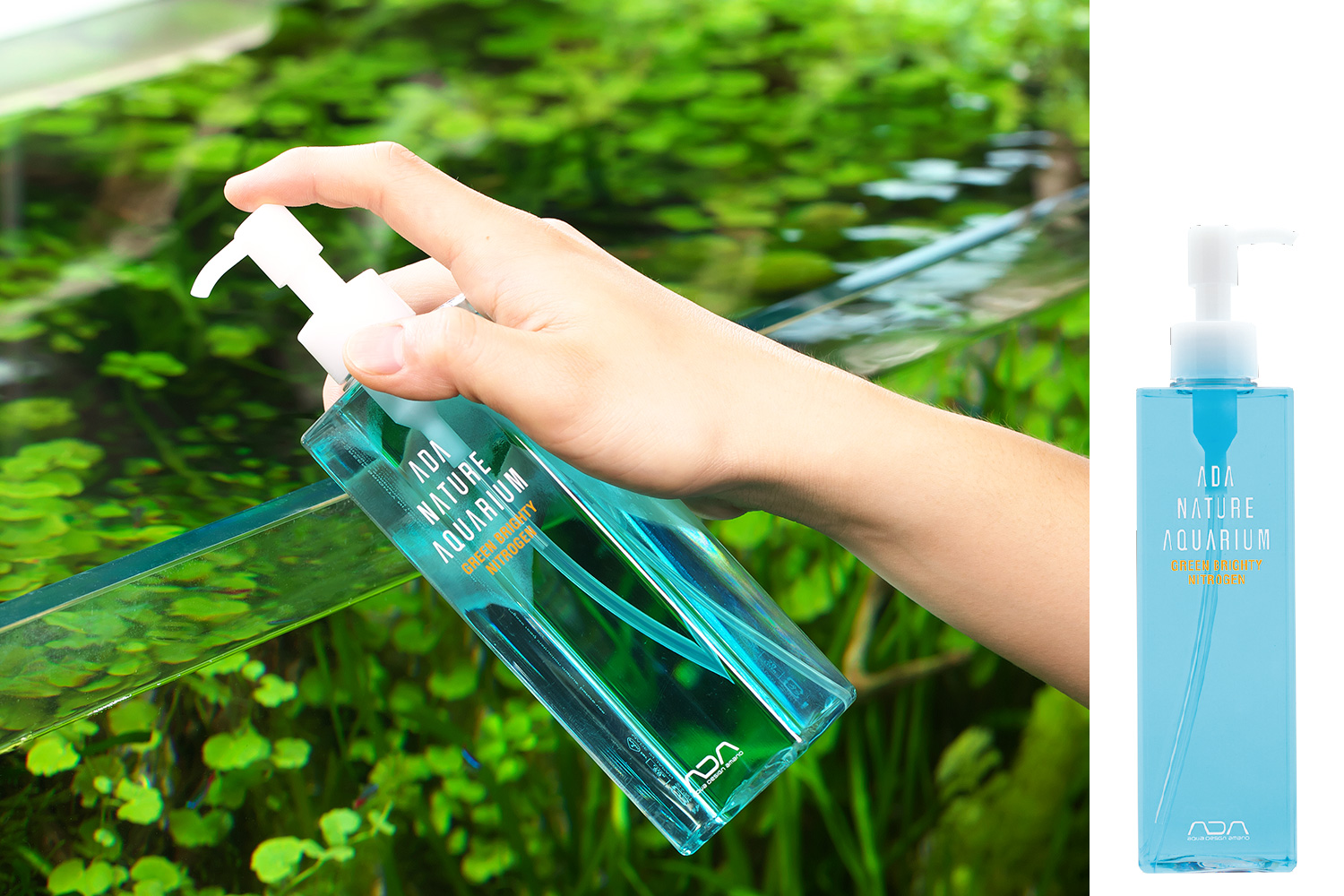
Green Brighty Nitrogen
When aquatic plants grow slower, and the leaf color tends to become lighter, adding Green Brighty Nitrogen is effective because it has the function of supplementing Nitrogen.
When aquatic plants grow slower, and the leaf color tends to become lighter, adding Green Brighty Nitrogen is effective because it has the function of supplementing Nitrogen.
Re-planting【 Limnophila sessiliflora 】
Because Limnophila sessiliflora is not so tolerant to picking and trimming, it needs to be re-planted when it grows taller. Not to define the border lines of aquatic plants, and to make it look natural, Limnophila sessiliflora was intentionally re-planted randomly, instead of aligning terminal buds of Limnophila sessiliflora. It means that it is a maintenance method not to overly align. It is important to adjust the timing for re-planting while paying attention to other aquatic plants. It was hard. It is likely for Limnophila sessiliflora to grow vertically. However, when it doesn’t get enough light, it shrinks and starts to melt from its lower stem. Therefore, it was necessary to thin out Limnobium sp. and Hydrocotyle leucocephala frequently near the water surface.
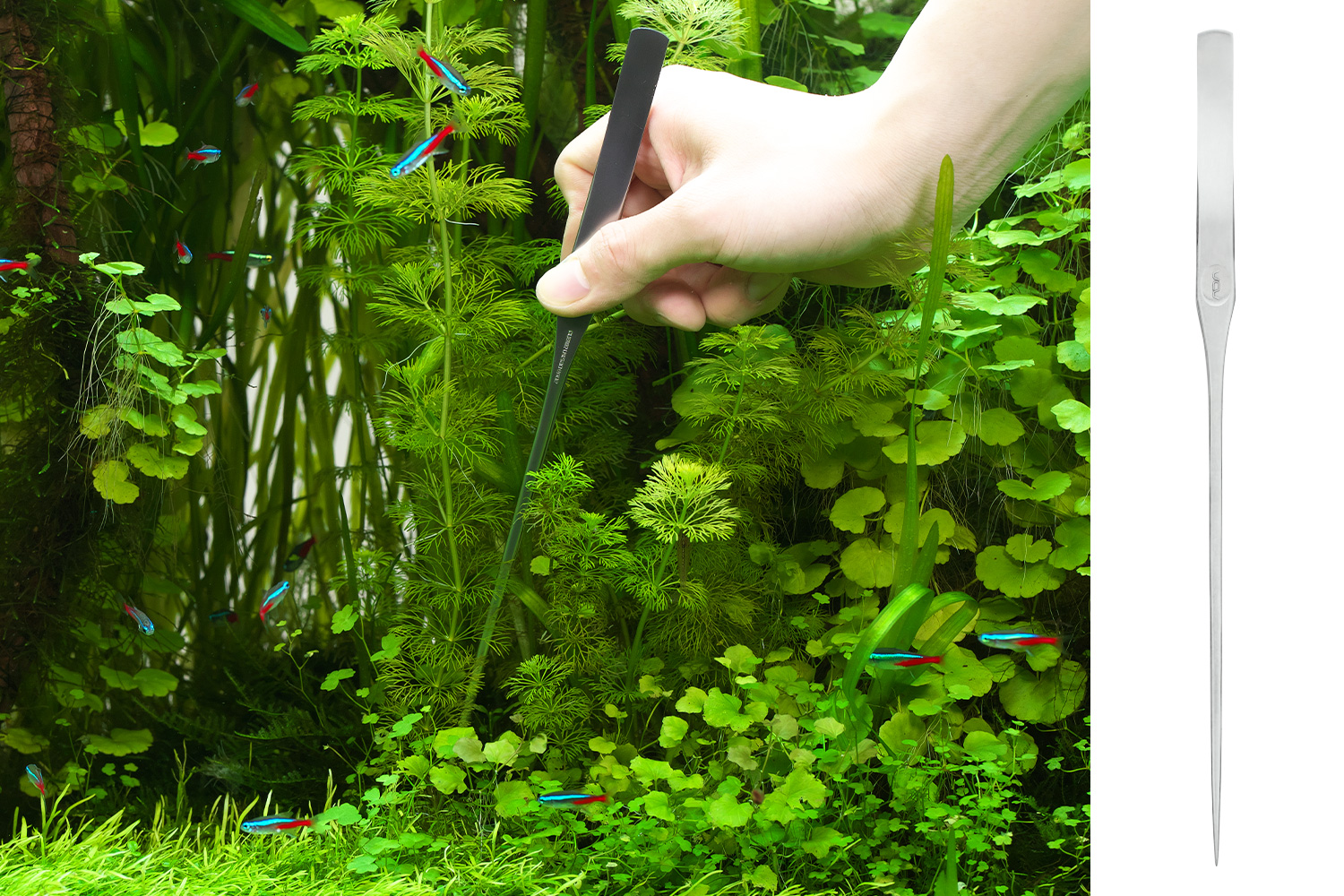
Pro Pinsettes L
Pro Pinsettes L has fine tips, and the work can be smoothly done even in a complicated composition. It is a must-have item for aquascapers.
Pro Pinsettes L has fine tips, and the work can be smoothly done even in a complicated composition. It is a must-have item for aquascapers.
Tricks for planting【 Utricularia graminifolia 】
While the whole aquascape is unified with light green, the aquatic plant that gives an exceptionally bright impression is Utricularia graminifolia. It becomes borderless between the foreground and midground because of the vigorous growth of Utricularia graminifolia. As a result, the expression became ambiguous. To make Utricularia graminifolia thrive faster, there is a method to mix it with Glossostigma at the beginning of planting. We would like to introduce the method to you here.
Utricularia graminifolia which has a tendency to grow in an oligotrophic condition, may be difficult to grow with new Aqua Soil Amazonia because of its rich nutrients. So, by planting it with Glossostigma, Glossostigma will absorb excess nutrients. It is a method to prepare an environment easy for Utricularia graminifolia to grow. Compared with Utricularia graminifolia that grows in an oligotrophic environment, Glossostigma that needs nutrients, gradually weakens. And even Utricularia graminifolia and Glossostigma are planted together, as time goes by, Utricularia graminifolia will start thriving as covering Glossostigma. Aqua Soil Amazonia Ver.2 that is easy to control nutrients, is also effective
Method of planting Utricularia graminifolia and Glossostigma together
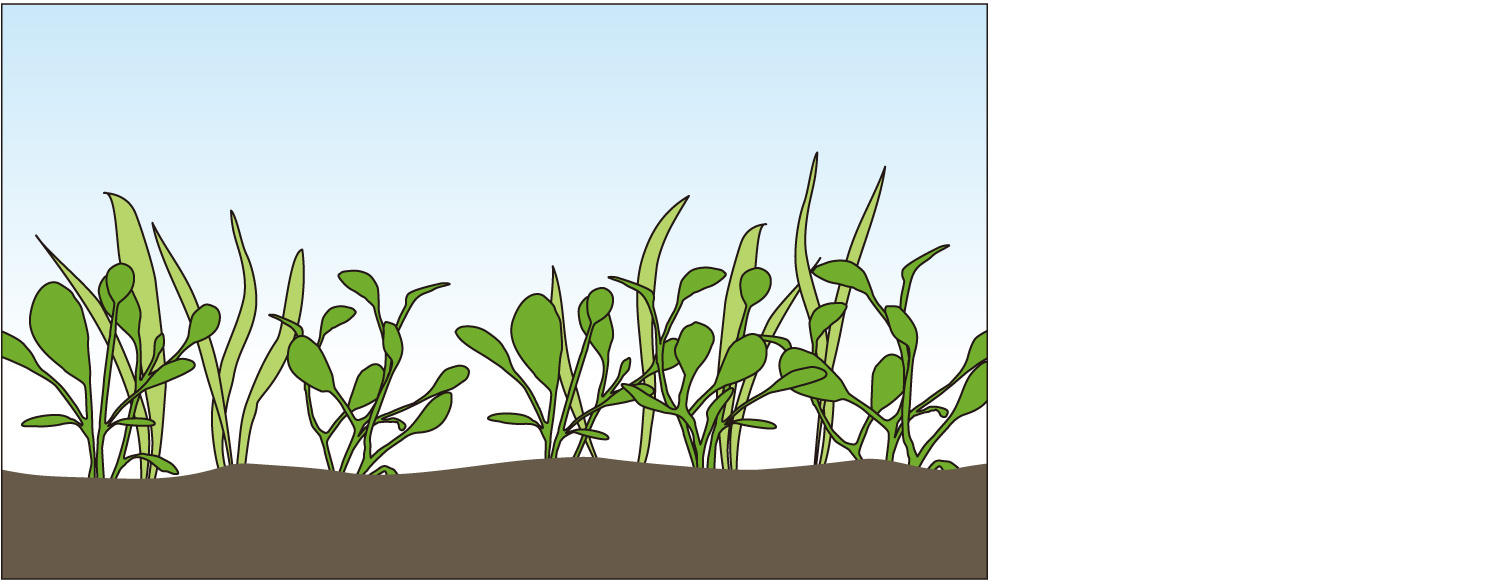
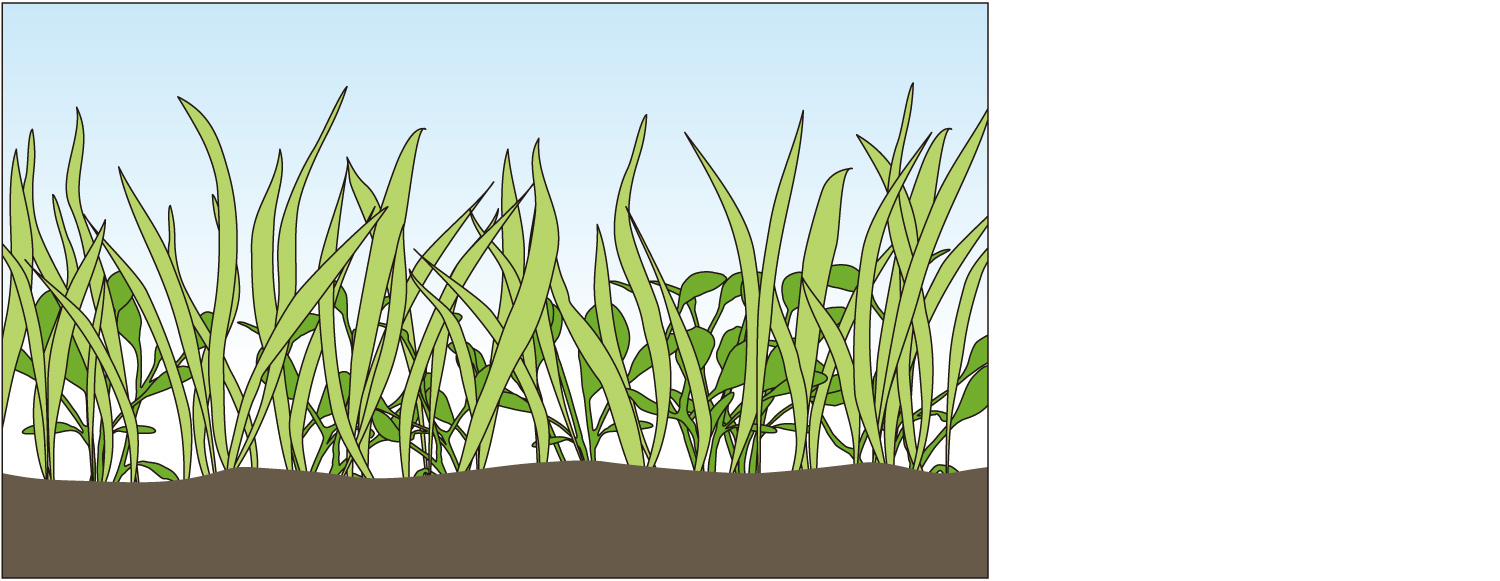
Utricularia graminifolia grows as covering Glossostigma.
Daisuke Inoue talks about his thinking process from getting ideas to completion, and what kind of aquascapes he is aiming for.
When creating aqusacapes, a genral theory is said to be paying attention to natural seceney such as rivers, mountains and oceans, and expressing them in a aquarium tank. But if it is only an approach, it ends up being biased for realistic expressions and stereotyped expressions. As a result, it sometimes lacks originality. So, to create your own unique aquascapes, decide concepts and themes first, and develop imaginations, and then embody a layout composition by replacing the imaginations by compositions, aquatic plants and fish as it goes.
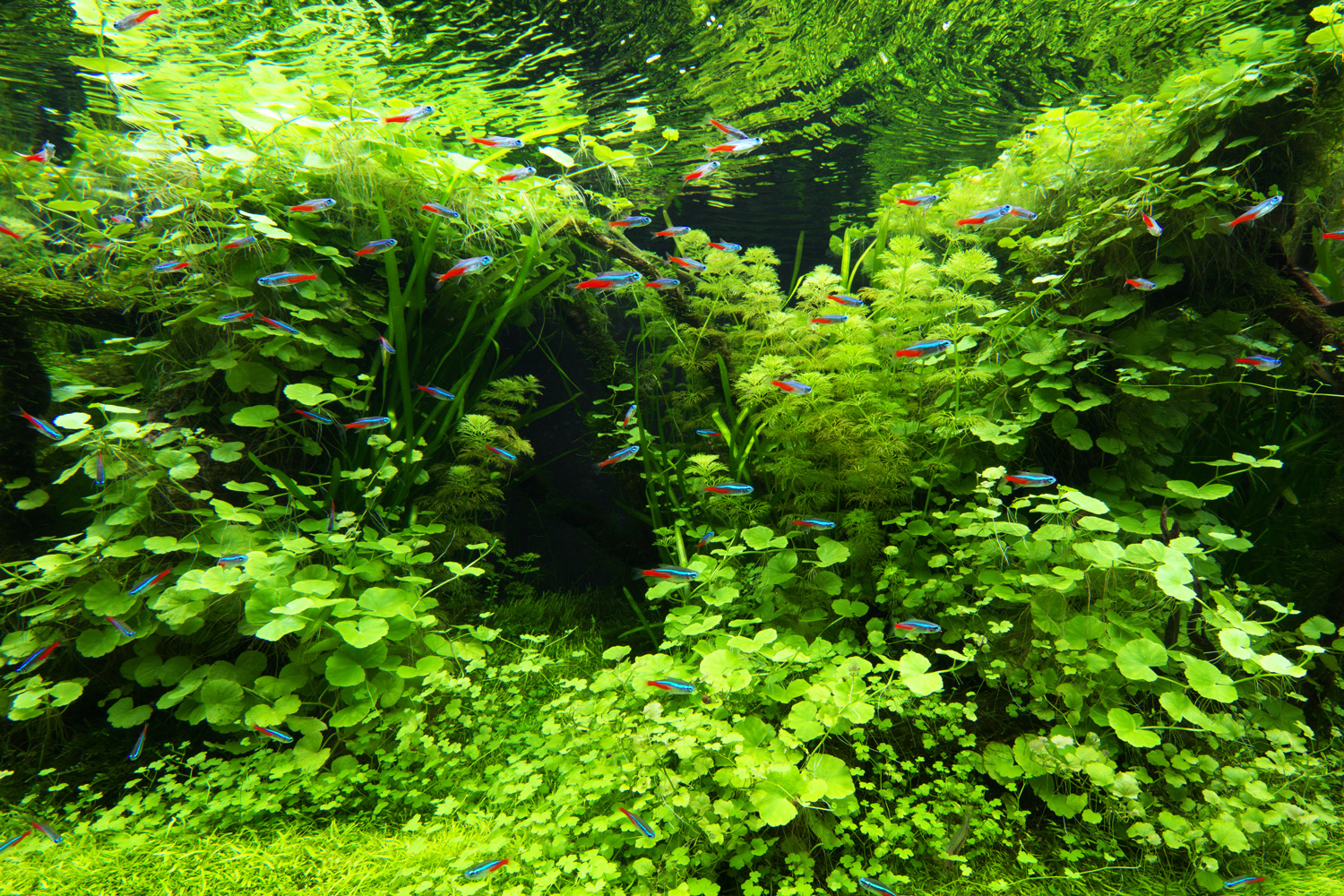
“Mystical” which is the theme for this aquasape is part of image reprentations such as “Fictinal”, “Dreamy”, “Unrealistic” and “Unbelievable”, instead of actual things like scenery. It doesn’t exist, and there is no example. It is very difficult to realize your imaginations, and it took so much time for me to embody them.
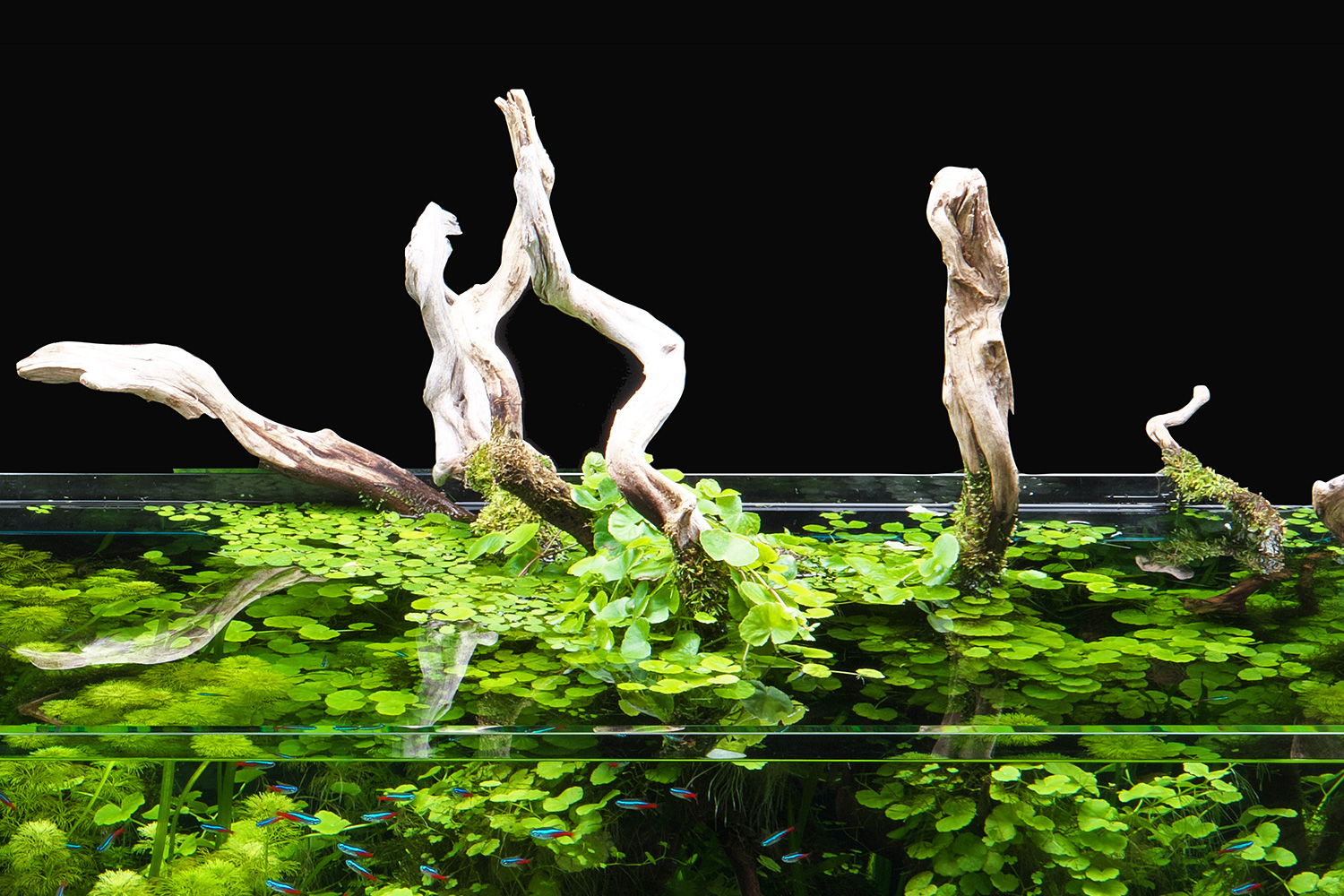
It is often said that aquascapes I create are eccentric. But I don’t mean to create eccentric aquascapes. As a result of pursuing to create what I really want, it just happens to be an unusual way to create aquascapes. Although opinions for my aquascapes are sometimes divided, I am basically aware of the Nature Aquarium concepts such as “Recreation of Nature” and “Aquascapes that look like framed nature”. I try not to call my aqusacpes works. It is because if I think about elaborately creating an aquascape, arrangements for stones and driftwood become too crafy when creating aquascapes as a SUIKEI creator. Personally, I aim to create aquascapes that can give people an opportunity to think about the beauty, strengh and importance of nature even if it is a small opportunity. (Inoue)
Layout composing method learned from examples to express one’s imagination
We continued the conversation with a SUIKEI creator, Daisuke Inoue who sticks to create unique aquascapes, and had him reflect the production processes of his 2 impressive aquascapes. His unique world of imaginations is never aiming for impacts or eccentricities. It is nothing but genuine. It seems that the secrets of Daisuke’s aquascape appeals exist there.
Eternity and the energy of lives
The theme for this aquascape is “Eternity and the energy of lives”, and in order for me to express the theme, I sought for a composition, aquatic plants and fish. As thinking about Yaku cedars that are over 1,000 years old, and envisioning the way the cedars develop roots while avoiding obstacles and rocks, I used Horn Woods that were very gnarled. I also added Sansui Stones around the Horn Woods, and intended to express the way roots of large trees intertwined.
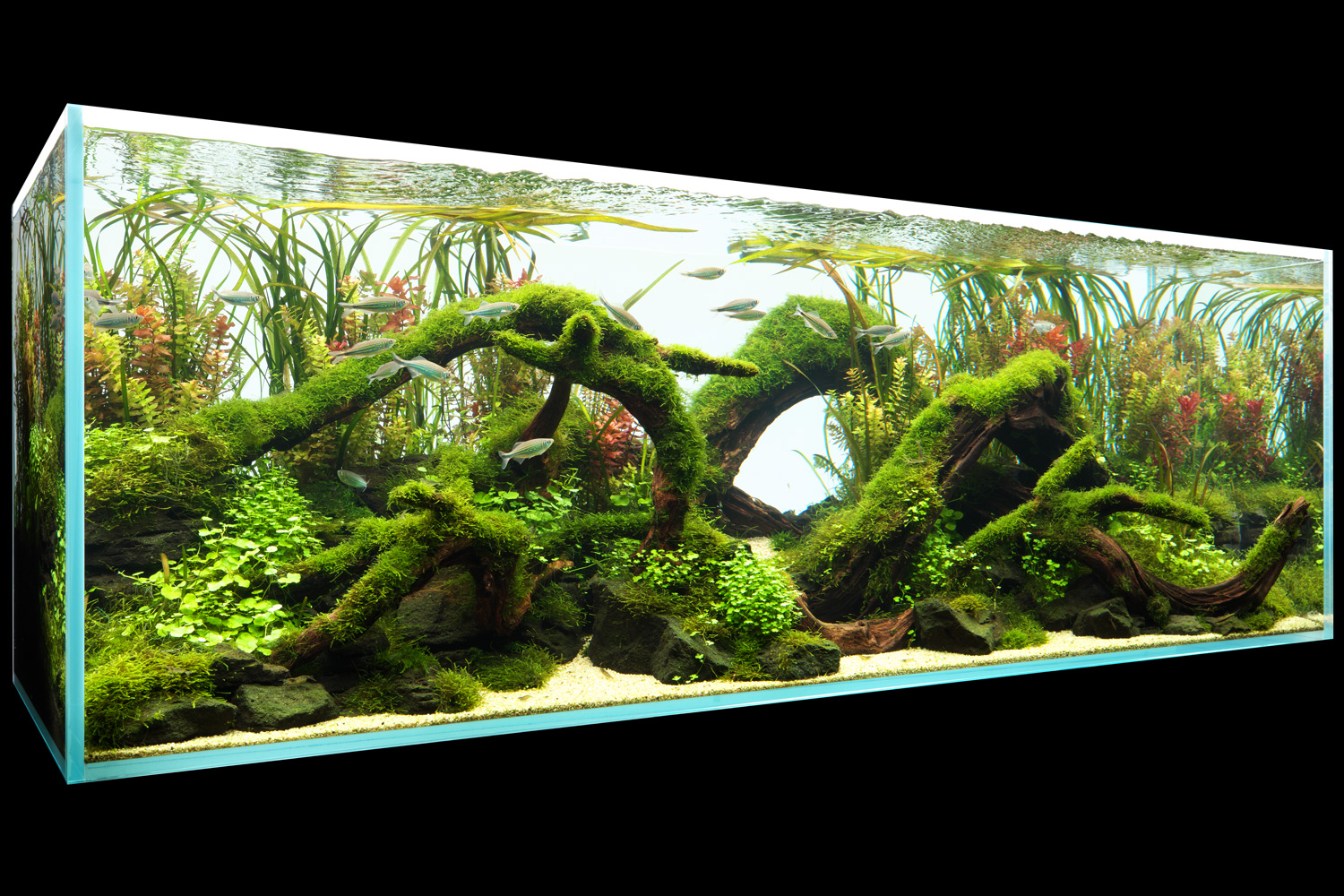
Size: W180×D60×H60(cm)
For the “Eternity” part, to express the way an old tree was covered with moss, I created a dense atmosphere by putting Taxiphyllum barbieri all over the driftwood. I also envisioned a forest floor where a lot of shade tolerant plants grow, and used Lilaeopsis ‘Novae zelandiae’ and Vallisneria spiralis ‘Leopard’ that are both relatively dark green.
For “the energy of lives” part, I used bright colorful stem plants such as Rotala macrandra, and made efforts to give freshness and reproducing capability of plants to the layout. And by placing Hydrocotyle sp. between Sansui Stones wrapped with moss, I was able to make runners of Hydrocotyle sp. look like they were crawling on Taxiphyllum barbieri. By doing so, I intended to give a vigorous reproducing capability of Hydrocotyle sp. like vines tangled on old trees and rocks. For fish, to match the image of a primitive forest, I chose Devario malabaricus with shining silver scales instead of flamboyant fish. I executed the way nature remains for a long time as the “Eternity”, and the aspect of nature that is newly born in a place where there was nothing before as “the energy of lives”. I expressed how many lives coexist in the flow of different times. (Inoue)
For “the energy of lives” part, I used bright colorful stem plants such as Rotala macrandra, and made efforts to give freshness and reproducing capability of plants to the layout. And by placing Hydrocotyle sp. between Sansui Stones wrapped with moss, I was able to make runners of Hydrocotyle sp. look like they were crawling on Taxiphyllum barbieri. By doing so, I intended to give a vigorous reproducing capability of Hydrocotyle sp. like vines tangled on old trees and rocks. For fish, to match the image of a primitive forest, I chose Devario malabaricus with shining silver scales instead of flamboyant fish. I executed the way nature remains for a long time as the “Eternity”, and the aspect of nature that is newly born in a place where there was nothing before as “the energy of lives”. I expressed how many lives coexist in the flow of different times. (Inoue)
Ancient world
In Nature Aquarium, it is common to create layouts by getting inspirations from natural scenery such as mountains and rivers. But this aquascape was formed from a scenery image of the times that can only be seen in fantasy pictures and movies. The time I chose as the theme was the Jurassic period which was said to be started about 200 million years ago. It is a layout expressing the ancient time when massive ferns thrived, and dinosaurs strode.
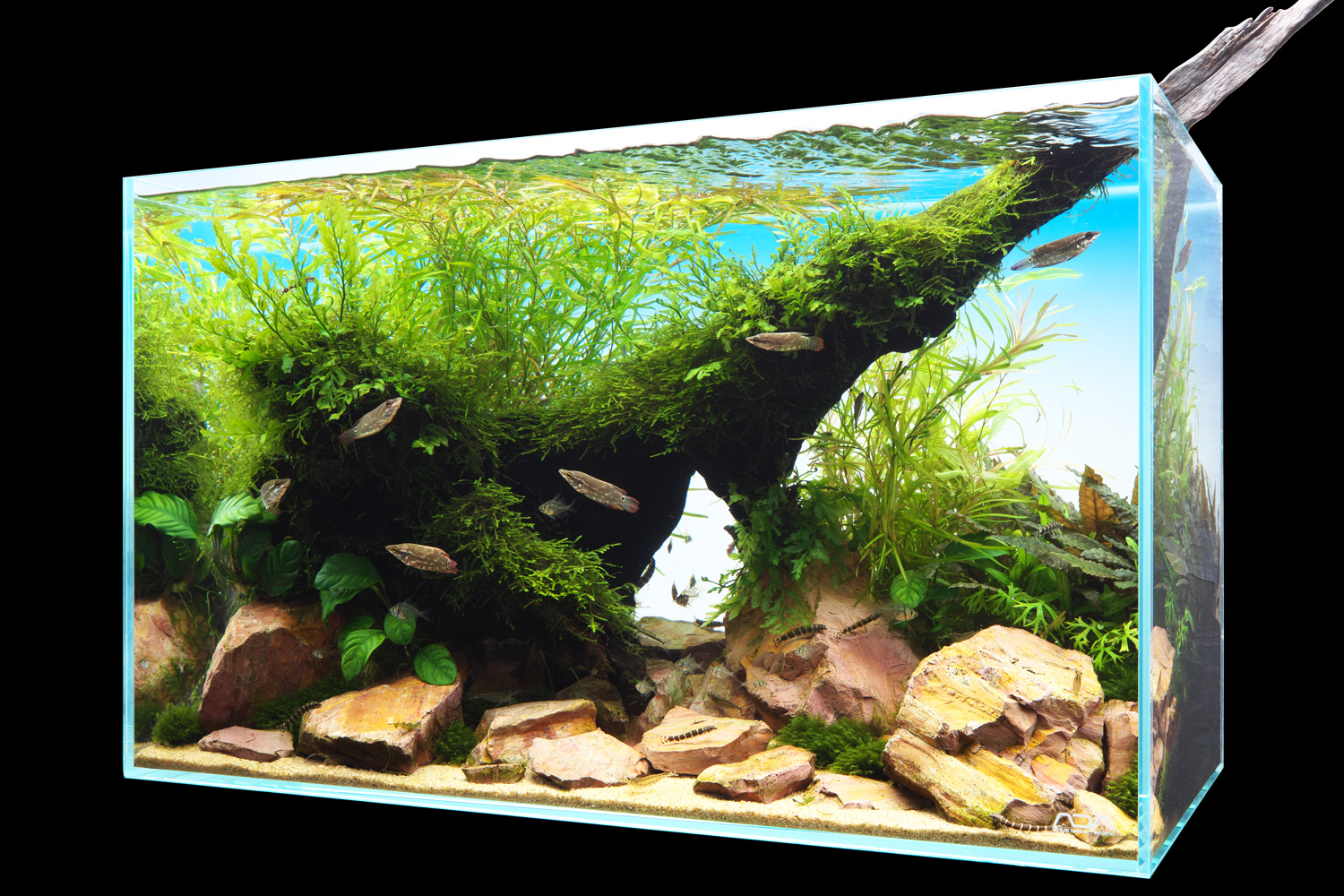
Size: W60×D30×H36(cm)
As I started the production, I thought about how I could make 3 elements such as composition, aquatic plants and fish closer to the image of the Jurassic period. For driftwood that would be a composition structure, I chose Horn Woods that had been used many times in other layouts to give the impression of the flow of time from the weathered wood surface. And Kei Stones were the best choice to create an atmosphere with sedimentary rocks where fossils could be excavated.
And to express cracks in the earth, Kei Stones without thickness were arranged on the cosmetic sand. The arrangement was fun to do. In addition to aquatic plants such as ferns and mosses that are said to have evolved without changing their shapes, I proactively chose unique aquatic plants such as Anubias barteri var. ‘Coffeefolia’ with the distinctive leaf color and shape, and Ranunculus inundatus that has the primitive impression. By planting plants that are rarely used in layouts, I intentionally created an unfamiliar world = a never seen before world. Because I uniformed fish with bizarre looks and distinctive swimming styles such as Parambassis ranga that has a transparent body like glass, and Ctenops nobilis that looks like a dinosaur, I think I was able to create a mysterious ambiance. (Inoue)
And to express cracks in the earth, Kei Stones without thickness were arranged on the cosmetic sand. The arrangement was fun to do. In addition to aquatic plants such as ferns and mosses that are said to have evolved without changing their shapes, I proactively chose unique aquatic plants such as Anubias barteri var. ‘Coffeefolia’ with the distinctive leaf color and shape, and Ranunculus inundatus that has the primitive impression. By planting plants that are rarely used in layouts, I intentionally created an unfamiliar world = a never seen before world. Because I uniformed fish with bizarre looks and distinctive swimming styles such as Parambassis ranga that has a transparent body like glass, and Ctenops nobilis that looks like a dinosaur, I think I was able to create a mysterious ambiance. (Inoue)
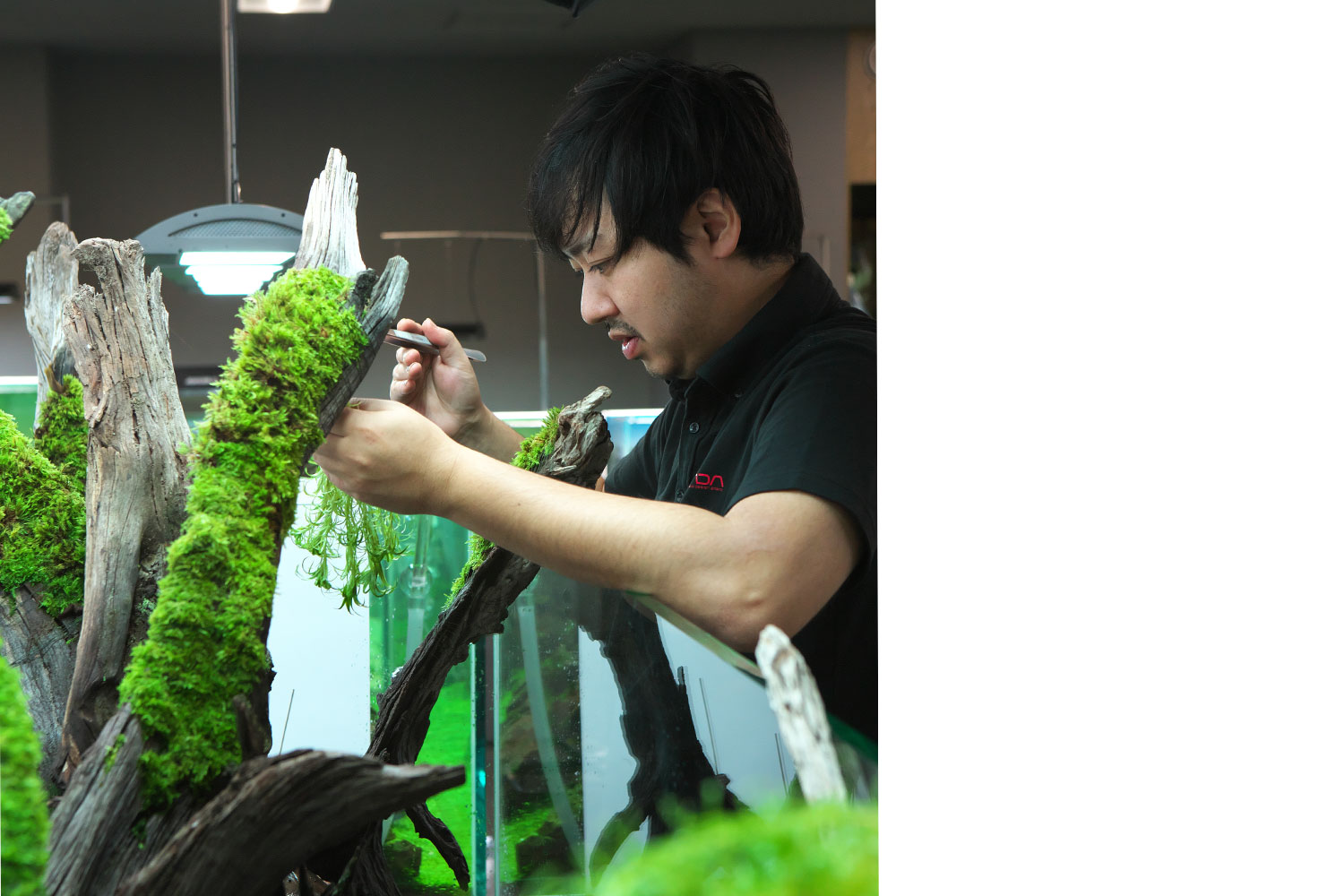
Among the ADA SUIKEI creators, he has a reputation for thinking outside the box and his unique approaches to creating aquascapes. He believes there should be a concept first.
